SUBFAMILY MYRMICINAE - Genus Monomorium key to species-groups and component species
| The Ants of
Africa SUBFAMILY MYRMICINAE - Genus Monomorium key to species-groups and component species |
|
| Monomorium Introduction |
Compiled largely from the groupings used by Bolton (1987). A few
curious points are as follows:
As the final column shows a number of species appear in Bolton's key in
what appear to be odd places relative to other members of a
species-group or species complex, e.g. Monomorium emeryi in the
destructor-group; hannonis in the setuliferum-complex;
hirsutum in the bicolor-complex.
The australe-complex of small to minute species contains what
appears to be a proliferation of species, primarily by raising early
so-called varieties to full species status, but Bolton did not give a
single illustration for any of the twelve members.
Note: Following the genus
redefinitions in Ward et al.
(2014: 10) the Syllophopsis from sub-Saharan
Africa are arnoldi (revived
from renaming as jonesi), cryptobia, elgonensis, malamixta, modesta, sersalata and thrascolepta.
Trichomyrmex from sub-Saharan Africa are - abyssinicus, plus "destructor-group"
- destructor, emeryi, epinotale, mayri, oscaris and robustior.
| Species-group (some ± = former sub-genus) subdivision into complexes |
No of members | Species | Bolton (1987) key couplet |
|---|---|---|---|
| Mandibles with 5 teeth | |||
| latinode-group | 1 | In full-face view head ovoid/rectangular, eyes set well forward; TL 2.6-3.2 mm | |
| . | . |  latinode
- tramp species - Tanzania - new genus definition pending (note in Ward
et al 2014) latinode
- tramp species - Tanzania - new genus definition pending (note in Ward
et al 2014) |
78 |
| Mandibles with 3-4 teeth | |||
| Genus Trichomymrex
part (scabriceps-group; Holcomyrmex, Bolton, 1987: 320) |
1 | 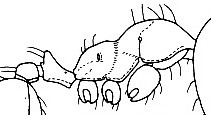 Mandibles
unsculptured; propodeal spiracle a short, near vertical, slit;
polymorphic Mandibles
unsculptured; propodeal spiracle a short, near vertical, slit;
polymorphic |
|
| . | . | 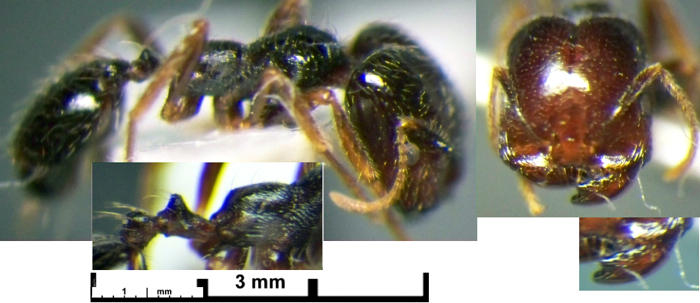 Trichomyrmex
abyssinicus
- TL 2.6-6.7 mm, HL 0.68-2.04; polymorphic, although exhibiting
monophasic allometry; granivorous with heavy mandibles; colour of
larger workers reddish brown to darker on head and alitrunk, gaster
darker again, smaller workers much lighter, still with gaster lighter -
across whole of Sahel zone Trichomyrmex
abyssinicus
- TL 2.6-6.7 mm, HL 0.68-2.04; polymorphic, although exhibiting
monophasic allometry; granivorous with heavy mandibles; colour of
larger workers reddish brown to darker on head and alitrunk, gaster
darker again, smaller workers much lighter, still with gaster lighter -
across whole of Sahel zone |
59 |
| Propodeal spiracle circular or nearly so | |||
| Propodeal dorsum either unsculptured or weak sculpture
that is not transverse |
|||
| Genus
Trichomyrmex part (formerly Monomorium destructor-group (Parholcomyrmex) |
6 | Propodeal dorsum always sculptured (even if faintly), usually transversely striate or costulate; with distinct angle at junction of propodeal dorsum & declivity (the angle may be rounded to sharp) | |
| . | . | 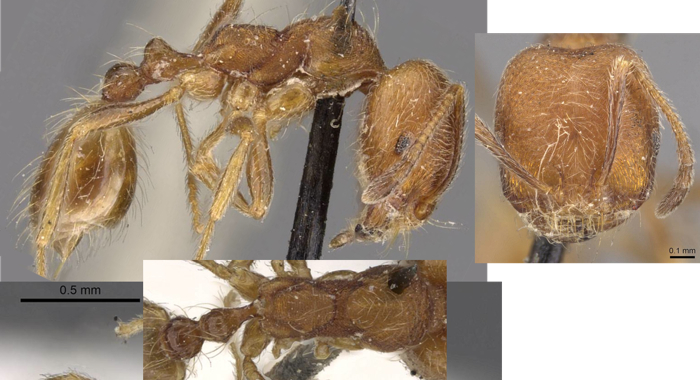 Trichomyrmex
emeryi
- dorsal surfaces evenly and coarsely sculptured; TL 2.5-3.4 mm -
southern Africa Trichomyrmex
emeryi
- dorsal surfaces evenly and coarsely sculptured; TL 2.5-3.4 mm -
southern Africa |
09 |
| . | . | More weakly sculptured | . |
| . | . |  Trichomyrmex
epinotale
- head and gaster yellow, alitrunk contrasting brown; TL 2.2-2.3 mm -
Zaïre - probable junior synonym of oscaris see below Trichomyrmex
epinotale
- head and gaster yellow, alitrunk contrasting brown; TL 2.2-2.3 mm -
Zaïre - probable junior synonym of oscaris see below |
62 & 85 |
| . | . | Not contrastingly coloured | . |
| . | . | 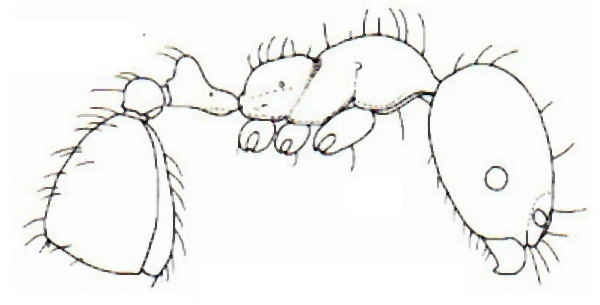 Trichomyrmex
mayri
-
head and alitrunk brown and with range of sizes (TL ca 2 mm) - Sahel
Zone Trichomyrmex
mayri
-
head and alitrunk brown and with range of sizes (TL ca 2 mm) - Sahel
Zone |
64 & 86 |
| . | . | 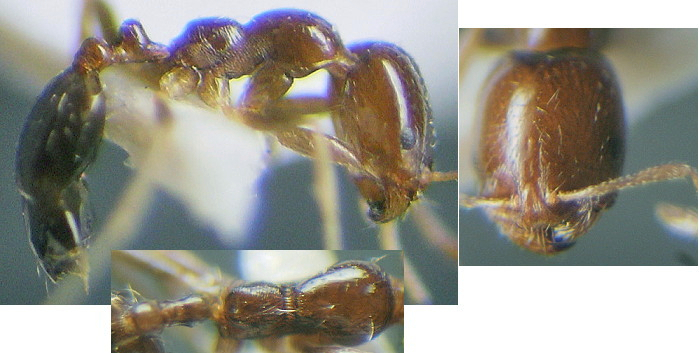 mayri mayri |
. |
| . | . |  Trichomyrmex
robustior
- head and alitrunk brown but uniformly sized; TL 2.5-3.4 mm - trans-soudanosavannah from Somalia west to Senegal Trichomyrmex
robustior
- head and alitrunk brown but uniformly sized; TL 2.5-3.4 mm - trans-soudanosavannah from Somalia west to Senegal |
64 |
| . | . | 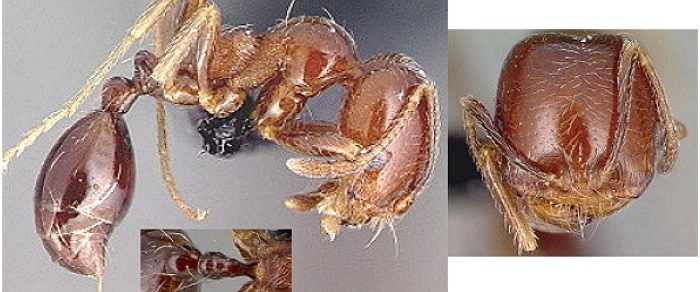 robustior robustior |
. |
| . | . | 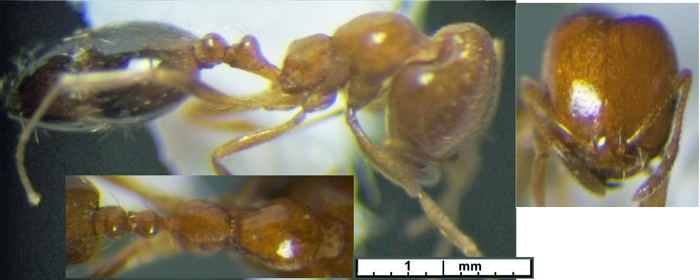 Trichomyrmex
destructor
- head and alitrunk yellow; petiole subglobular in dorsal view; TL
1.8-3.5 mm - widespread tramp species Trichomyrmex
destructor
- head and alitrunk yellow; petiole subglobular in dorsal view; TL
1.8-3.5 mm - widespread tramp speciesMajor |
65 & 87 |
| . | . | 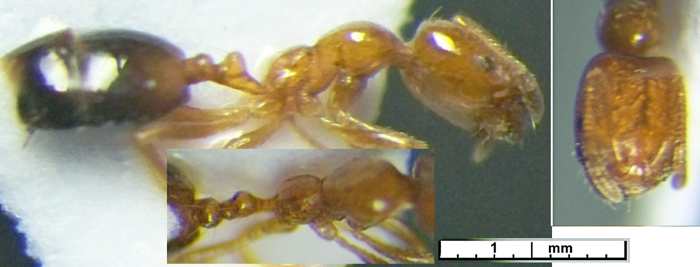 Minor Minor |
. |
| . | . |  Trichomyrmex oscaris - major head with
distinct longitudinal rugae on genae; dorsum more
weakly sculptured but strong transversely on propodeum; head and
alitrunk yellow, petiole profile compressed and ovoid in dorsal view;
monophasic allometry: TL 1.6-3.8 mm - pan-African savannah and open
areas Trichomyrmex oscaris - major head with
distinct longitudinal rugae on genae; dorsum more
weakly sculptured but strong transversely on propodeum; head and
alitrunk yellow, petiole profile compressed and ovoid in dorsal view;
monophasic allometry: TL 1.6-3.8 mm - pan-African savannah and open
areas |
09 & 65 & 87 |
| . | . | 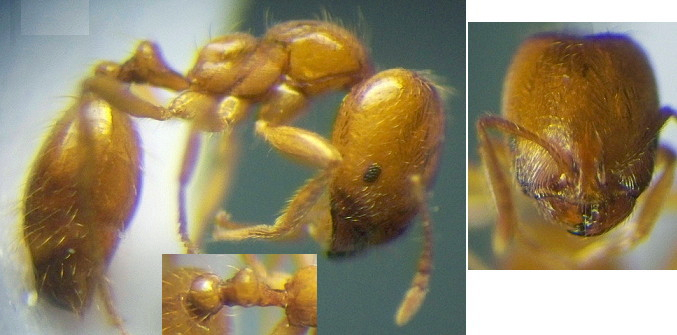 oscaris major
worker oscaris major
worker |
. |
| . | . | 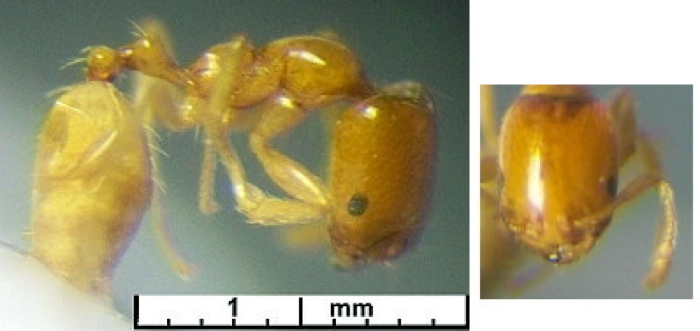 oscaris minima
worker oscaris minima
worker |
. |
| Propodeal dorsum smooth or with weak sculpture that is not transverse | |||
| Eyes with more than 2 ommatidia |
|||
| Genus Syllophopsis (formerly Monomorium fossulatum-group) |
7 | Eyes minute (1-2 ommatidia only); mandibles smooth; propodeum mostly with small tubercles at junction of dorsum and declivity | |
| . | . | 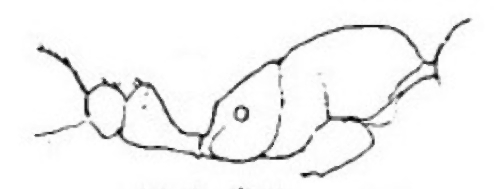 Syllophopsis
modesta
- metanotal groove visible but only slightly impressed; TL 1.7-2.0 mm -
east and southern Africa (plus an Ivory Coast population) Syllophopsis
modesta
- metanotal groove visible but only slightly impressed; TL 1.7-2.0 mm -
east and southern Africa (plus an Ivory Coast population) |
67 |
| . | . |  modesta modesta |
. |
| . | . | Metanotal groove a V- or U-shaped impression | . |
| . | . | Blackish or blackish brown | . |
| . | . | 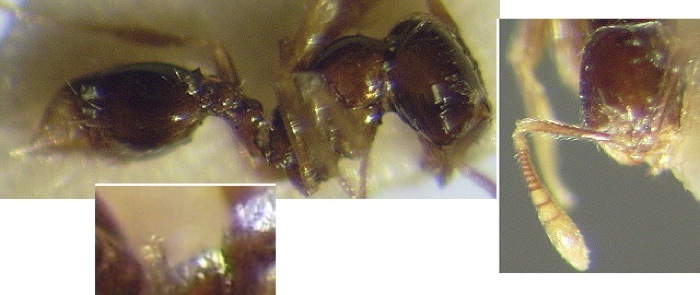 Syllophopsis
malamixta
- lower mesonotum sculptured, propodeum with narrow transverse ridge;
TL 1.6-2.0 mm - West Africa Syllophopsis
malamixta
- lower mesonotum sculptured, propodeum with narrow transverse ridge;
TL 1.6-2.0 mm - West Africa |
69 |
| . | . | 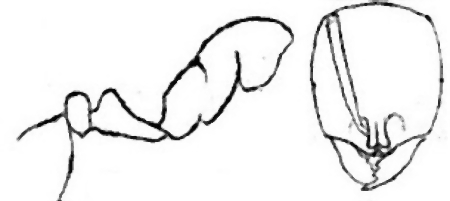 Syllophopsis
cryptobia
- lower mesonotum smooth; propodeum without a narrow transverse ridge
but with distinct minute tubercles at the postero-lateral angles; TL
1.3-1.7 mm; colour usually dull yellow to light brownish yellow - West
Africa & Congo Basin Syllophopsis
cryptobia
- lower mesonotum smooth; propodeum without a narrow transverse ridge
but with distinct minute tubercles at the postero-lateral angles; TL
1.3-1.7 mm; colour usually dull yellow to light brownish yellow - West
Africa & Congo Basin |
69 & 71 |
| . | . |  cryptobia cryptobia |
. |
| . | . | Yellow | . |
| . | . | Syllophopsis
sersalata
- lower mesonotum sculptured; TL 2.2 mm - Rwanda |
70 |
| . | . | Lower mesonotum smooth | . |
| . | . |  Syllophopsis
elgonensis
- antennal scapes relatively short, SI 91-95; TL 1.9-2.0 mm - Kenya Syllophopsis
elgonensis
- antennal scapes relatively short, SI 91-95; TL 1.9-2.0 mm - Kenya |
72 |
| . | . |  |
. |
| . | . | Scapes relatively long, SI 103-100 | . |
| . | . | 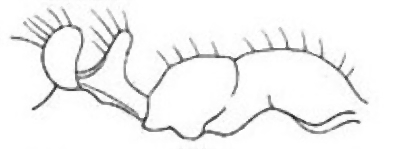 Syllophopsis
arnoldi (jonesi)
- head and scapes with only very short pubescence; TL 2.2-2.3 mm -
South Africa Syllophopsis
arnoldi (jonesi)
- head and scapes with only very short pubescence; TL 2.2-2.3 mm -
South Africa |
73 |
| . | . | 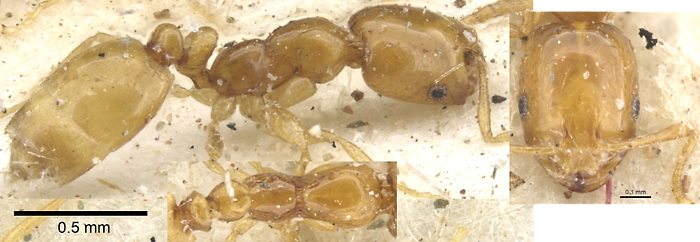 |
. |
| . | . |  Syllophopsis
thrascolepta
- head and scapes with dense erect pubescence; TL 1.9-2.2 mm - Ivory
Coast Syllophopsis
thrascolepta
- head and scapes with dense erect pubescence; TL 1.9-2.2 mm - Ivory
Coast |
73 |
| . | . | 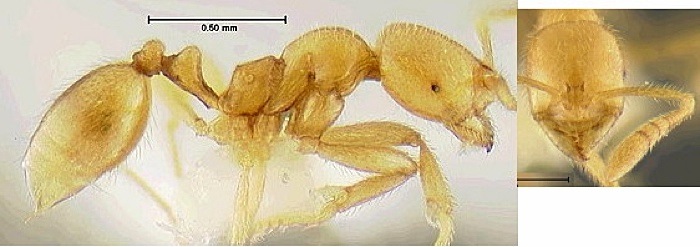 thrascolepta thrascolepta |
. |
| Genus Monomorium | |||
| Frontal lobes not very close and
propodeum rounded |
|||
| hanneli-group | 5 |  Frontal
lobes set close together; propodeum angular to bidentate in profile Frontal
lobes set close together; propodeum angular to bidentate in profile |
|
| . | . | 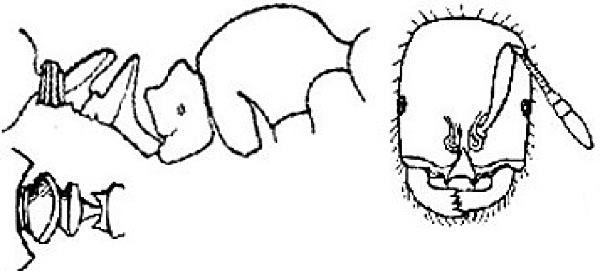 guineense
- both pedicel segments with narrow profile and postpetiole wider than
petiole; TL 2.3 mm - Guinea to Cameroun guineense
- both pedicel segments with narrow profile and postpetiole wider than
petiole; TL 2.3 mm - Guinea to Cameroun |
90 |
| . | . |  guineense guineense |
. |
| . | . | Postpetiole with lower domed node | . |
| . | . | Light to medium-brown | . |
| . | . | 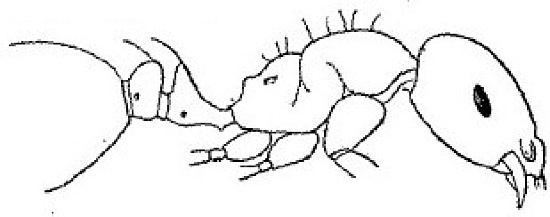 hanneli
- eye with more than 10 ommatidia; TL 2.4-2.8 mm - East Africa
(Angola?); includes former valtinum
(eye with only 6-7 ommatidia; TL 1.8-1.9 mm - Kenya) hanneli
- eye with more than 10 ommatidia; TL 2.4-2.8 mm - East Africa
(Angola?); includes former valtinum
(eye with only 6-7 ommatidia; TL 1.8-1.9 mm - Kenya) |
82 |
| . | . |  hanneli hanneli |
. |
| . | . | Dark brown to near black | . |
| . | . |  invidium
- propodeum dorsum weakly sculptured; TL 1.8-2.0 mm - West Africa invidium
- propodeum dorsum weakly sculptured; TL 1.8-2.0 mm - West Africa |
81 & 90 |
| . | . | 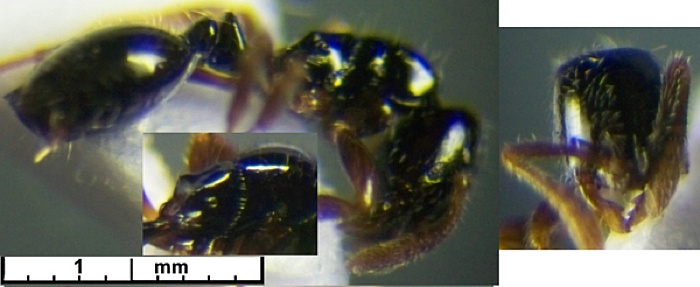 invidium invidium |
. |
| . | . |  jacksoni
- propodeum dorsum transversely rugose, rest of alitrunk quite strongly
sculptured; pronotum distinctly laterally marginate; TL 1.8-2.0 mm -
Cameroun & Congo jacksoni
- propodeum dorsum transversely rugose, rest of alitrunk quite strongly
sculptured; pronotum distinctly laterally marginate; TL 1.8-2.0 mm -
Cameroun & Congo |
80 |
| Eyes oval or circular |
|||
| setuliferum-group | 8 | 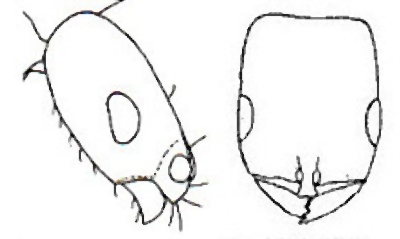 Eyes
set forward of mid-point of head and reniform or at least drawn
to a point ventrally in profile Eyes
set forward of mid-point of head and reniform or at least drawn
to a point ventrally in profile |
|
| macrops-complex | 1 | With a narrow head; also mesonotum and propodeum without standing hairs | . |
| . | . |  macrops
- light to medium brown; TL 2.0-2.1 mm - South Africa macrops
- light to medium brown; TL 2.0-2.1 mm - South Africa |
61 |
| . | . | 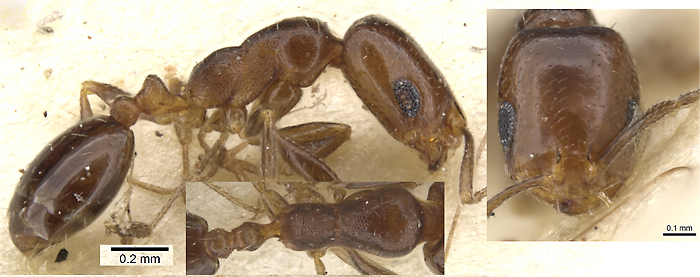 |
. |
| setuliferum-complex | 5 | Head and alitrunk sculptured, often densely | . |
| . | . | 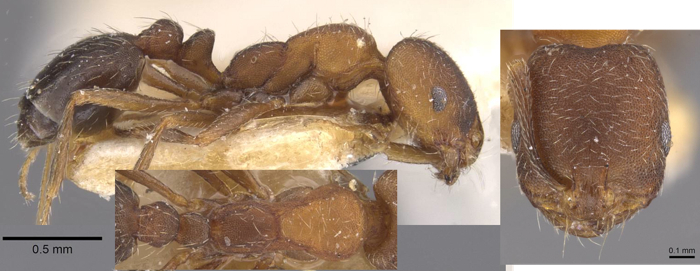 hannonis
- with numerous erect hairs; densely sculptured, brown; TL 2.7-2.8 mm -
Congo Basin hannonis
- with numerous erect hairs; densely sculptured, brown; TL 2.7-2.8 mm -
Congo Basin |
08 |
| . | . | With no erect hairs on head or body | . |
| . | . | 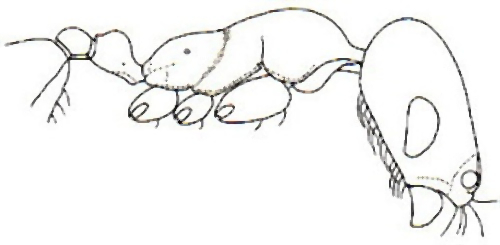 alamarum
- weakly sculptured, dark brown;TL 2.0-2.4 mm - Namibia alamarum
- weakly sculptured, dark brown;TL 2.0-2.4 mm - NamibiaThe drawing appears to be incorrect! |
25 |
| . | . | 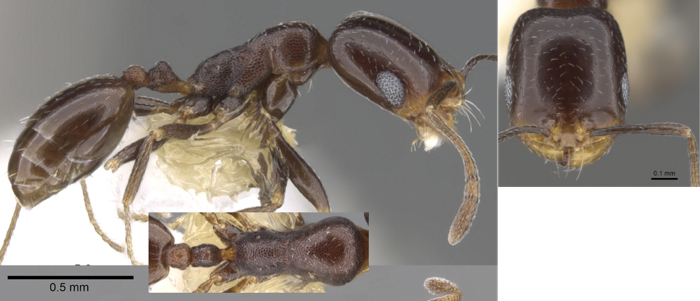 alamarum alamarum |
25 |
| . | . | Strongly sculptured | . |
| . | . |  nyasae
- small eyes, cinnamon yellow, with some darker areas; TL 2.5 mm -
Malawi nyasae
- small eyes, cinnamon yellow, with some darker areas; TL 2.5 mm -
Malawi |
21 |
| . | . |  notulum
- large eyes but not strongly reniform, brown, usually with gaster
darker; TL 2.0-2.4 mm - southern Africa notulum
- large eyes but not strongly reniform, brown, usually with gaster
darker; TL 2.0-2.4 mm - southern Africamay = the Bolton (1987) description of ebangaense |
21 |
| . | . | 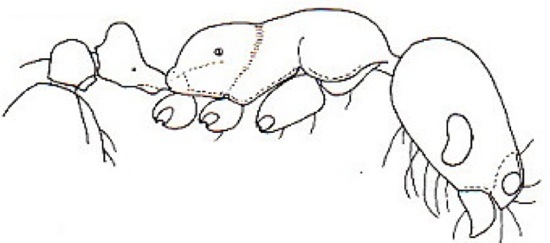 setuliferum
- large eyes which are conspicuously reniform; variable yellow to quite
dark yellow-brown; TL 2.5-2.7 mm - Botswana setuliferum
- large eyes which are conspicuously reniform; variable yellow to quite
dark yellow-brown; TL 2.5-2.7 mm - Botswana |
20 |
| . | . | 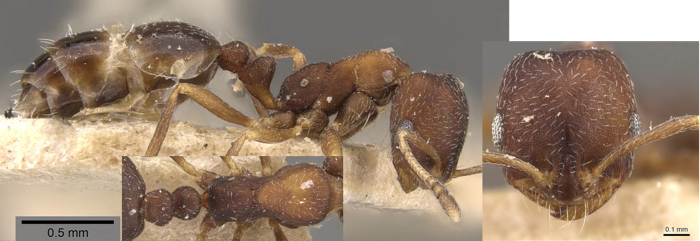 |
. |
| havilandi-complex | 2 | Smooth and unsculptured, also with numerous erect hairs (members seem lumped together) | . |
| . | . | 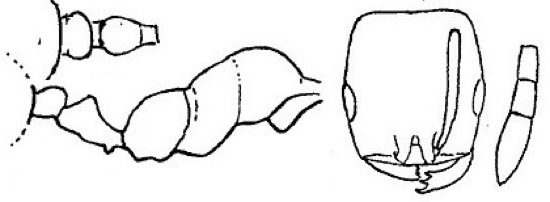 havilandi
- mandibles with only three teeth, uniformly blackish-brown to black,
gaster often shiny jet black, TL 2.8-3.1 mm - South Africa havilandi
- mandibles with only three teeth, uniformly blackish-brown to black,
gaster often shiny jet black, TL 2.8-3.1 mm - South Africa |
61 |
| . | . |  havilandi havilandi |
. |
| . | . | 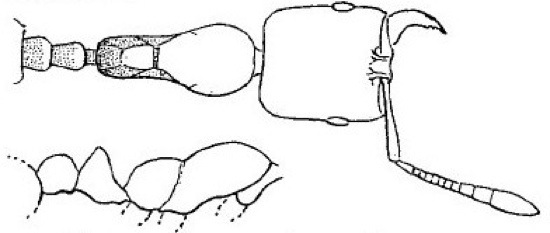 xanthognathum
- mandibles falcate; glossy blackish-brown, mandibles conspicuously
bright yellow; TL 2.5-2.7 mm - South Africa xanthognathum
- mandibles falcate; glossy blackish-brown, mandibles conspicuously
bright yellow; TL 2.5-2.7 mm - South Africa |
88 |
| . | . | 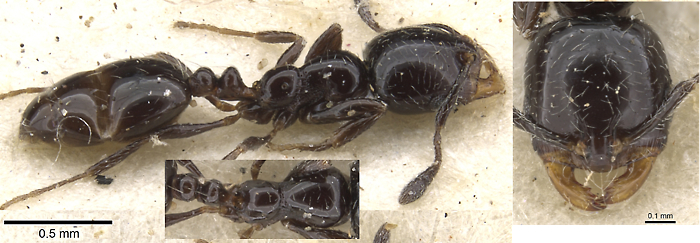 |
. |
| Eye set around mid-point of side of head and not reniform or elongated | |||
| Propodeal dorsum unsculptured |
|||
| salomonis-group
(Xeromyrmex) |
48 | Propodeum with dense very fine granular or reticulo-punctate sculpturation; antennae with 12 segments; alitrunk dorsum without any standing hairs | |
| Head weakly sculptured to near smooth |
|||
| Head uniformly and densely sculptured | |||
| . |  Uniform yellow-orange
colour other than variable darker
shade to apex of gaster - Uniform yellow-orange
colour other than variable darker
shade to apex of gaster - |
||
| . | 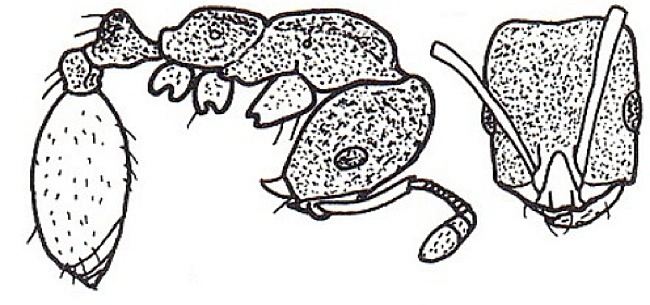 Orange-red;
gaster dark near black - Orange-red;
gaster dark near black - |
||
| . |  Head,
alitrunk and gaster uniformly dull brown; in most petiole with
relatively short stout pedicel - Head,
alitrunk and gaster uniformly dull brown; in most petiole with
relatively short stout pedicel - |
||
| pharaonis-complex | 1 | . | |
| . | . |  pharaonis
- TL 2.2-2.4 mm; yellow-orange, apex of gaster dark; head, alitrunk and
pedicel finely and densely reticulopunctate; erect hairs relatively
long and moderately abundant on the head and gaster; antennae
12-segmented; sides of head convex in front view with a smooth curve to
a slightly convex occipital margin - pan-global tramp pharaonis
- TL 2.2-2.4 mm; yellow-orange, apex of gaster dark; head, alitrunk and
pedicel finely and densely reticulopunctate; erect hairs relatively
long and moderately abundant on the head and gaster; antennae
12-segmented; sides of head convex in front view with a smooth curve to
a slightly convex occipital margin - pan-global tramp |
14 |
| . | . |  pharaonis pharaonis |
. |
| bicolor-complex | 6 | . | |
| . | . | Pronotum dorsum with erect hairs | . |
| . | . | 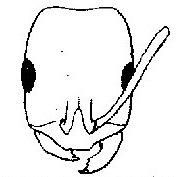 nitidiventre
- pronotum dorsum with a pair of hairs at the anterior angles; TL
2.5-2.8 mm; head rather shorter and scapes not or barely reaching
occiput; head with more numerous psammophore type hairs on underside;
also head and alitrunk shiny; gaster also shiny with a bluish sheen -
Sudan, Tanzania
nitidiventre
- pronotum dorsum with a pair of hairs at the anterior angles; TL
2.5-2.8 mm; head rather shorter and scapes not or barely reaching
occiput; head with more numerous psammophore type hairs on underside;
also head and alitrunk shiny; gaster also shiny with a bluish sheen -
Sudan, Tanzania |
NA |
| . | . | 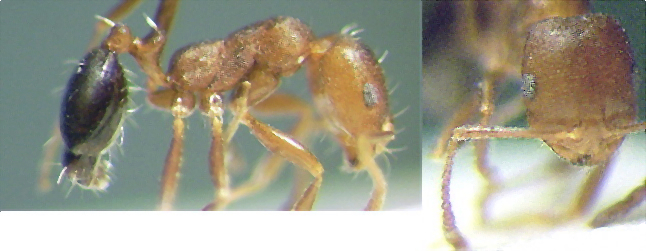 nitidiventre nitidiventre |
. |
| . | . |  hirsutum
- pronotum dorsum with many erect hairs; also with small eyes; TL
3.2-3.4 mm; overall orange-yellow to orange-red, gaster blackish-brown
to black - Eritrea hirsutum
- pronotum dorsum with many erect hairs; also with small eyes; TL
3.2-3.4 mm; overall orange-yellow to orange-red, gaster blackish-brown
to black - Eritrea |
07 |
| . | . | Without erect hairs on pronotum | . |
| . | . | 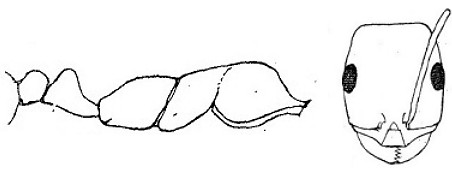 niloticum
- TL 3.0-3.3 mm; head larger in front than behind; eyes relatively
large; head, alitrunk and petiole very finely shagreened, slightly
shiny, gaster almost smooth and brilliant; colour of head, alitrunk,
petiole and legs yellow-red; gaster black - Sudan, Egypt niloticum
- TL 3.0-3.3 mm; head larger in front than behind; eyes relatively
large; head, alitrunk and petiole very finely shagreened, slightly
shiny, gaster almost smooth and brilliant; colour of head, alitrunk,
petiole and legs yellow-red; gaster black - Sudan, Egypt |
NA |
| . | . | 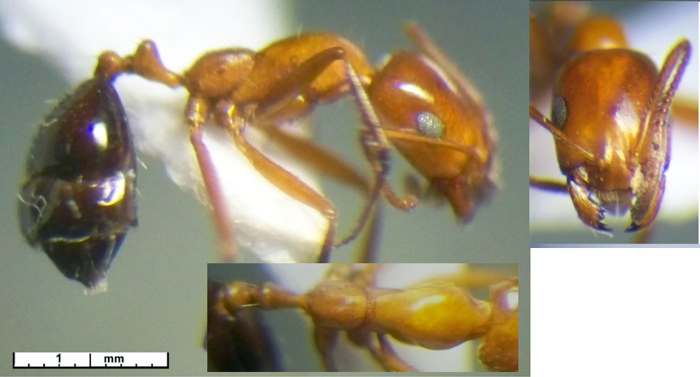 niloticum - much
more distinctly shiny niloticum - much
more distinctly shiny |
. |
| . | . | 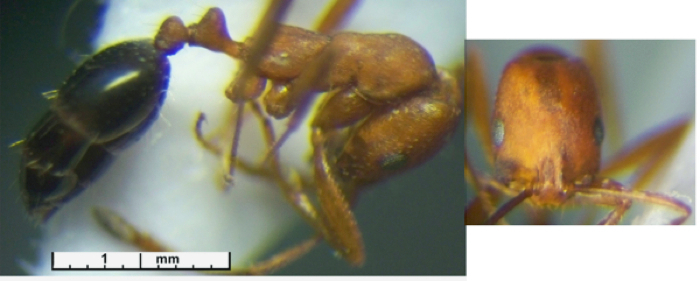 niloticum niloticoides
-overall finely sculptured giving a matt appearance niloticum niloticoides
-overall finely sculptured giving a matt appearance |
. |
| . | . |  bicolor
- TL at least 2.9 mm; base of gaster dorsum with sparse pilosity,
usually only 1-3 pairs of hairs - very widespread north of the
Equator bicolor
- TL at least 2.9 mm; base of gaster dorsum with sparse pilosity,
usually only 1-3 pairs of hairs - very widespread north of the
Equator |
42 |
| . | . | 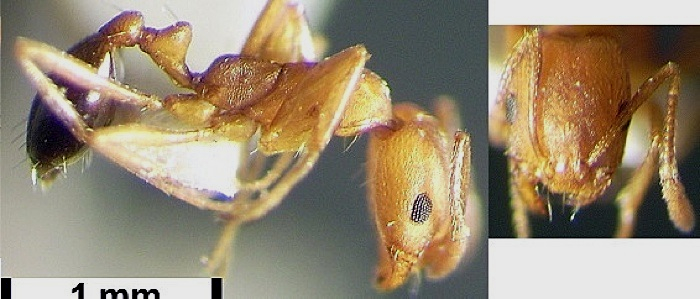 bicolor bicolor |
. |
| . | . | 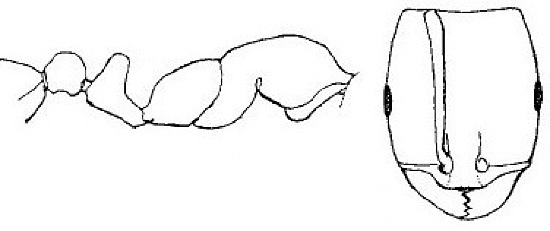 ebangaense
- TL 2.2 mm, red promesonotum lighter, gaster black; confused status -
Angola ebangaense
- TL 2.2 mm, red promesonotum lighter, gaster black; confused status -
Angola |
(key misleading) |
| . | . | Base of gaster dorsum with 6-8 or more pairs of hairs | . |
| . | . |  rufulum
- with well developed ammochaete hairs on underside of head; TL 3.0-3.6
mm; dull orange to reddish-brown on all but gaster, which is darker
brown to blackish-brown often with a paler spot or streak
antero-medially - southern Africa rufulum
- with well developed ammochaete hairs on underside of head; TL 3.0-3.6
mm; dull orange to reddish-brown on all but gaster, which is darker
brown to blackish-brown often with a paler spot or streak
antero-medially - southern Africa |
13 & 40 |
| . |
. |
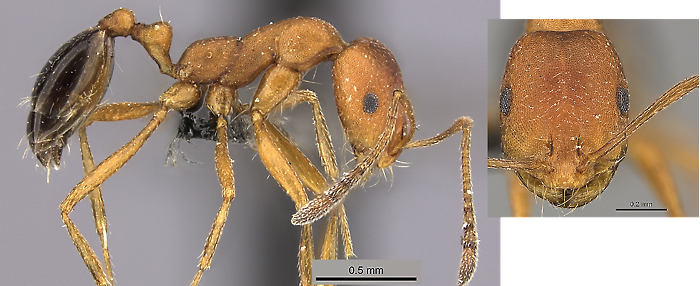 rufulum rufulum |
|
| . | . | With no more than short hairs on underside of head | . |
| . | . | 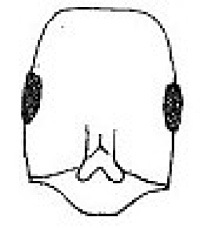 personatum
- with relatively large eyes 0.31-0.33 X HW; TL 3.3-3.3 mm; head and
alitrunk bright red but anterior of head, scapes and antennal club
darkish brown - Angola personatum
- with relatively large eyes 0.31-0.33 X HW; TL 3.3-3.3 mm; head and
alitrunk bright red but anterior of head, scapes and antennal club
darkish brown - Angola |
41 |
| . | . | 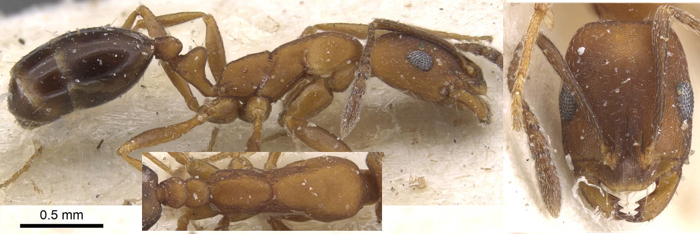 |
. |
| . | . | With smaller eyes, 0.23-0.27 X HW | . |
| . | . |  westi
- anterior margin of clypeus concave, with lateral projecting teeth; TL
3.0-3.2 mm; all except gaster orange to dull orange, the gaster
strongly contrasting blackish-brown to black - Kenya westi
- anterior margin of clypeus concave, with lateral projecting teeth; TL
3.0-3.2 mm; all except gaster orange to dull orange, the gaster
strongly contrasting blackish-brown to black - Kenya |
43 |
| . | . |  |
. |
| . | . | 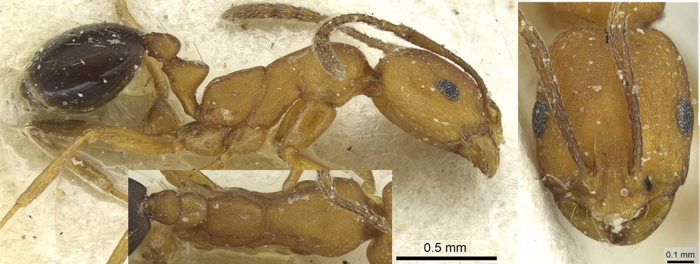 dictator
- anterior margin of clypeus only weakly concave and without projecting
lateral teeth; TL 2.9 mm; generally red to orange-red except wholly
blackish-brown to black gaster - Angola & Gambia dictator
- anterior margin of clypeus only weakly concave and without projecting
lateral teeth; TL 2.9 mm; generally red to orange-red except wholly
blackish-brown to black gaster - Angola & Gambia |
43 |
| opacum-complex | 6 | . | |
| . | . | Pronotum dorsum with erect hairs | . |
| . | . |  albopilosum
- pronotum dorsum and propodeum dorsum with erect hairs, TL 3.4-4.4 mm;
uniform light to dark brown - southern Africa albopilosum
- pronotum dorsum and propodeum dorsum with erect hairs, TL 3.4-4.4 mm;
uniform light to dark brown - southern Africa |
07 |
| . | . | 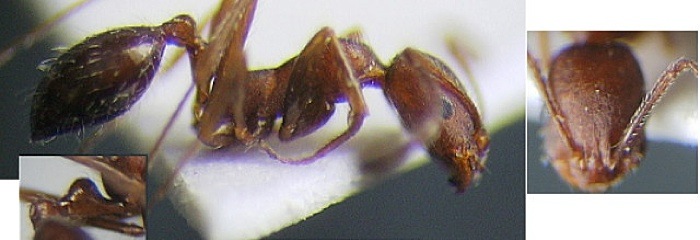 albopilosum albopilosum |
. |
| . | . | 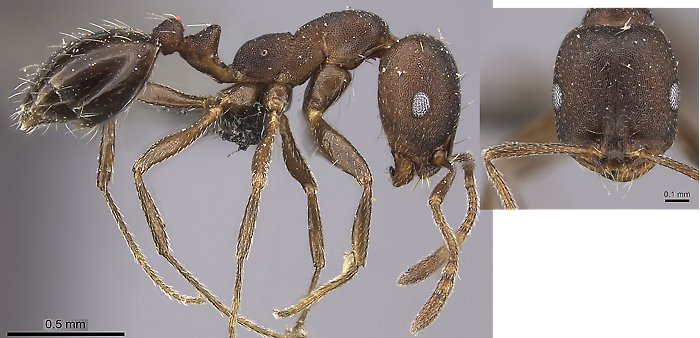 junodi
-
propodeum dorsum without erect hairs; TL 2.8-3.6 mm; uniform medium to
dark brown - south-eastern Africa junodi
-
propodeum dorsum without erect hairs; TL 2.8-3.6 mm; uniform medium to
dark brown - south-eastern Africa |
14 |
| . | . | Pronotum dorsum without erect hairs | . |
| . | . | 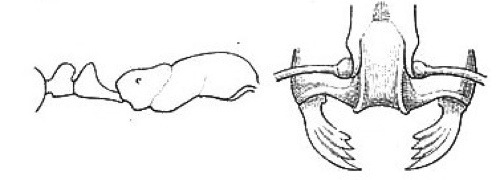 afrum -
first tergite of gaster without erect hairs; TL 3.6-4.3 mm; head in
profile with a distinct posteroventral occipital angle; uniform medium
to dark brown - sub-Saharan Africa except far south afrum -
first tergite of gaster without erect hairs; TL 3.6-4.3 mm; head in
profile with a distinct posteroventral occipital angle; uniform medium
to dark brown - sub-Saharan Africa except far south |
22 |
| . | . |  afrum afrum |
. |
| . | . | First tergite of gaster with erect hairs | . |
| . | . | micropacum
- first tergite of gaster with about 10 pairs of hairs; smaller TL 2.4
mm; dull light brown - South Africa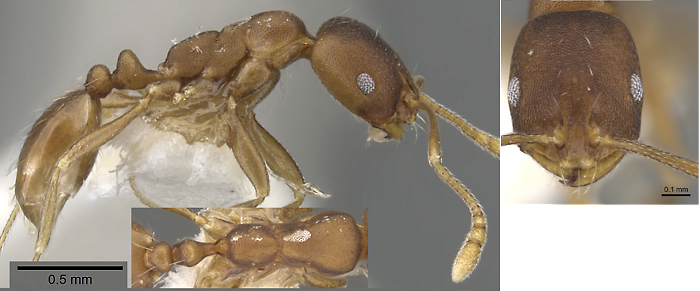 |
38 |
| . | . | First tergite of gaster with only 1-2 pairs of hairs anterior to apical row; larger | . |
| . | . |  opacum -
propodeum profile almost horizontal with smooth transition into
declivity; TL 3.3-3.5 mm; yellowish to pale medium brown - eastern
Africa opacum -
propodeum profile almost horizontal with smooth transition into
declivity; TL 3.3-3.5 mm; yellowish to pale medium brown - eastern
Africa |
39 |
| . | . |  subdentatum
- propodeum profile sloping posteriorly, with angled transition into
declivity; TL 3.1-3.3 mm; yellowish to pale medium brown - Zaïre subdentatum
- propodeum profile sloping posteriorly, with angled transition into
declivity; TL 3.1-3.3 mm; yellowish to pale medium brown - Zaïre |
39 |
| Head weakly sculptured to near smooth | |||
| Petiole with a short peduncle | |||
| . |  Distinctive large eyes and near square heads; head with
sculpturation of fine reticulation overlayed by fine striations - areniphilum-complex
- Distinctive large eyes and near square heads; head with
sculpturation of fine reticulation overlayed by fine striations - areniphilum-complex
- |
||
| . |  Reduced
sculpturation, so generally quite shiny - salomonis-complex
- Reduced
sculpturation, so generally quite shiny - salomonis-complex
- |
||
| . | 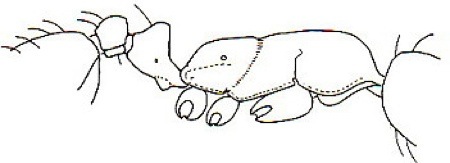 Head much less strongly or distinctly sculptured; in most
petiole with moderate pedicel subtended by a blunt process; generally
brownish, with lighter appendages - subopacum-complex - Head much less strongly or distinctly sculptured; in most
petiole with moderate pedicel subtended by a blunt process; generally
brownish, with lighter appendages - subopacum-complex - |
||
| Petiole with a relatively long peduncle | |||
| . | 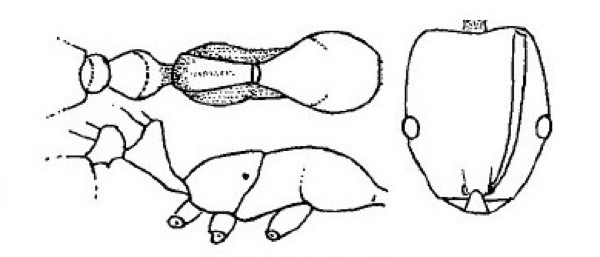 Sculpturation even
more reduced, with head and alitrunk
similar - tchelichofi-complex - Sculpturation even
more reduced, with head and alitrunk
similar - tchelichofi-complex - |
||
| . |  Much reduced
sculpturation, large eyes and long to very
long scapes; elongated overall shape - viator-complex - Much reduced
sculpturation, large eyes and long to very
long scapes; elongated overall shape - viator-complex - |
||
| . | With
reduced sculpturation and reduced pilosity (a catch-all collection) - mediocre-complex
- |
||
| . | Small
to minute species, with fine sculpturation giving silky appearance
[Curiously there are no illustrations in the literature - despite the
proliferation of species by Bolton, 1987] - australe-complex - |
||
| areniphilum-complex | 2 | Distinctive large eyes and near square heads; head with sculpturation of fine reticulation overlayed by fine striations | |
| . | . |  areniphilum
- distinctive large eyes, HW = HL; head with sculpturation of fine
reticulation overlayed by fine striations; TL 3.1-4.3 mm; variable
brown - Sahel zone areniphilum
- distinctive large eyes, HW = HL; head with sculpturation of fine
reticulation overlayed by fine striations; TL 3.1-4.3 mm; variable
brown - Sahel zone |
23 & 51 |
| . | . |  areniphilum areniphilum |
. |
| . | . | 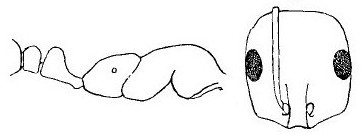 pullulum
new status - TL 3.7-4.0 mm; head about 1/6
longer than wide, with convex sides and straight occipitum; black with
a little brownish; mandibles, funiculi, anterior of pronotum, base of
petiole, genae and tarsi reddish-brown; densely reticulate, granular
and matt - Sahel zone pullulum
new status - TL 3.7-4.0 mm; head about 1/6
longer than wide, with convex sides and straight occipitum; black with
a little brownish; mandibles, funiculi, anterior of pronotum, base of
petiole, genae and tarsi reddish-brown; densely reticulate, granular
and matt - Sahel zone |
not in key |
| . | . |  pullulum pullulum |
. |
| salomonis-complex | 2 | Reduced sculpturation, so generally quite shiny | |
| . | . | 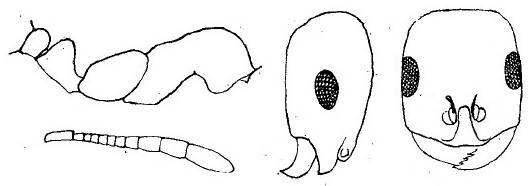 salomonis
- TL 2.5-3.5 mm; moderately shiny; variably coloured brown with gaster
darker - widespread tramp salomonis
- TL 2.5-3.5 mm; moderately shiny; variably coloured brown with gaster
darker - widespread tramp |
not in key |
| . | . |  salomonis salomonis |
. |
| . | . | 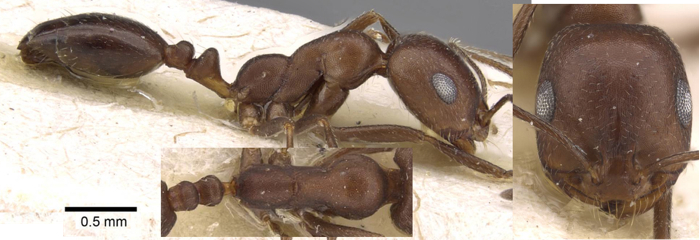 hercules
- TL 3.1-3.6 mm; dark red brown, with redder mandibles - Sudan -seems
likely to be a junior synonym of salomonis hercules
- TL 3.1-3.6 mm; dark red brown, with redder mandibles - Sudan -seems
likely to be a junior synonym of salomonis |
not in key |
| subopacum-complex | 8 | Head much less strongly or distinctly sculptured; in most petiole with longer pedicel subtended by a blunt process; generally brownish, with lighter appendages | |
| . | . | 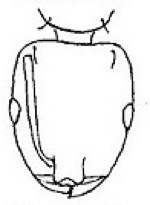 delagoense
- pronotum dorsum with erect hairs; TL 3.1-3.9 mm; uniform dark brown -
Mozambique & South Africa delagoense
- pronotum dorsum with erect hairs; TL 3.1-3.9 mm; uniform dark brown -
Mozambique & South Africa |
15 |
| . | . | 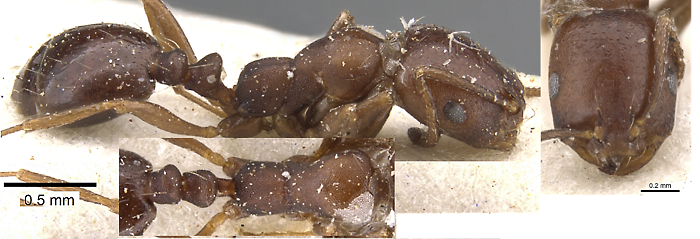 |
15 |
| . | . | Pronotum dorsum without erect hairs | . |
| . | . | Dorsum of head with no more than faint
patterning, polished and shiny drapenum - dorsum of head with erect hairs; TL 2.4-2.6 mm; head and gaster dark brown, remainder lighter - Namibia  |
32 |
| . | . | 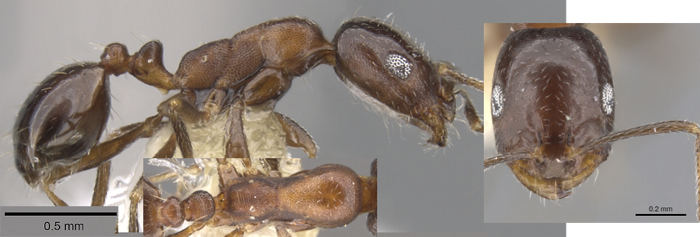 |
. |
| . | . | Dorsum of head without erect hairs | . |
| . | . | 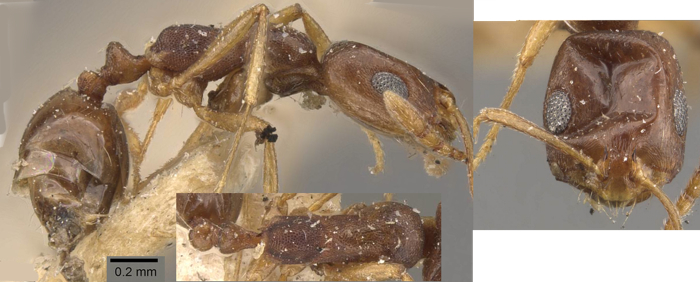 ophthalmicum
- with relatively large eyes and short scapes; mesonotum dips to
metanotal suture but that is not impressed; TL 2.3 mm; medium brown,
legs and antennae dull yellow - Ethiopia ophthalmicum
- with relatively large eyes and short scapes; mesonotum dips to
metanotal suture but that is not impressed; TL 2.3 mm; medium brown,
legs and antennae dull yellow - Ethiopia |
31 |
| . | . | kitectum
- alitrunk with smooth near flat profile; TL 2.2-2.3 mm; brown wth
gaster darker - Namibia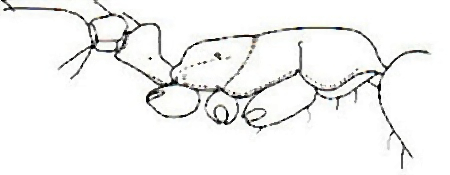 |
32 |
| . | . | 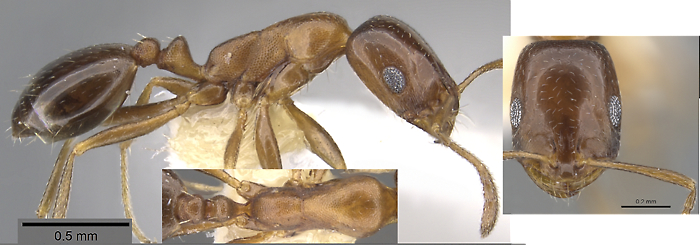 |
. |
| . | . |  willowmorense
- alitrunk with impressed metanotal suture, TL 2.5-3.0 mm; medium
brown, gaster usually darker - South Africa willowmorense
- alitrunk with impressed metanotal suture, TL 2.5-3.0 mm; medium
brown, gaster usually darker - South Africa |
32 |
| . | . |  |
. |
| . | . | Dorsum of head with distinct sculpturation, at least enough to give dull appearance | . |
| . | . |  ocellatum
- first gastral tergite with numerous evenly distributed erect hairs;
TL 3.1-3.7 mm - South Africa ocellatum
- first gastral tergite with numerous evenly distributed erect hairs;
TL 3.1-3.7 mm - South Africa |
48 |
| . | . | First gastral tergite with sparse erect hairs | . |
| . | . |  herero -
anterior clypeal margin straight; dorsum of head with 3-4 pairs of
erect hairs; TL 2.8-3.1 mm - Namibia herero -
anterior clypeal margin straight; dorsum of head with 3-4 pairs of
erect hairs; TL 2.8-3.1 mm - Namibia |
53 |
| . | . | 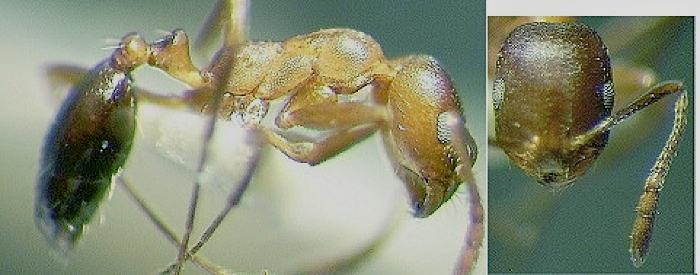 subopacum
- anterior clypeal margin indented; TL ca 2.4 mm - widespread
semi-desert species in northern Africa, introduced to South Africa subopacum
- anterior clypeal margin indented; TL ca 2.4 mm - widespread
semi-desert species in northern Africa, introduced to South AfricaNote Bolton (1987) had TL 3.1-3.4; Mayr (1861: 72) for mediterraneum had TL 2.8-3.0 ; yellowish brown-red; gaster darker than head and alitrunk |
53 |
| tchelichofi-complex | 5 | Sculpturation even more reduced, with head and alitrunk similar | |
| . | . | Promesonotum with erect hairs | . |
| . | . | 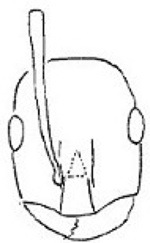 excelsior
- glossy dark brown, TL 3.3-3.5 mm - South Africa excelsior
- glossy dark brown, TL 3.3-3.5 mm - South Africa |
11 |
| . | . | 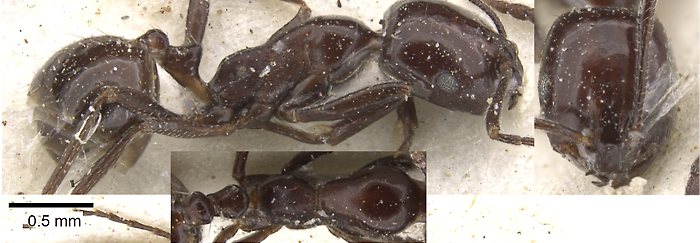 |
. |
| . | . | 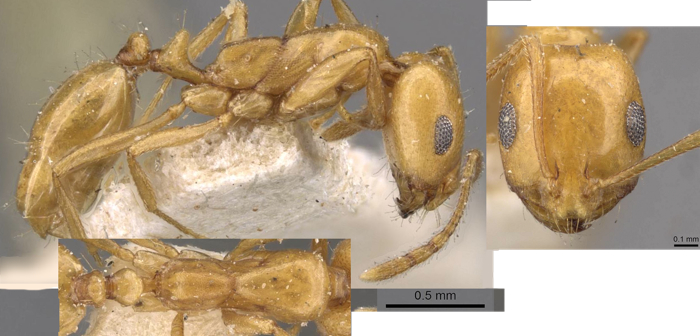 ilgii
-
uniform yellow, TL 2.7-3.1 mm - Ethiopia ilgii
-
uniform yellow, TL 2.7-3.1 mm - Ethiopia |
11 |
| . | . | Promesonotum without erect hairs | . |
| . | . |  orangiae
- promesonotum sculpture almost effaced, propodeum with
distinct lateral margination; petiole node smooth; TL 3.7-4.0 mm;
uniform dark glossy brown - South Africa orangiae
- promesonotum sculpture almost effaced, propodeum with
distinct lateral margination; petiole node smooth; TL 3.7-4.0 mm;
uniform dark glossy brown - South Africa |
34 |
| . | . | 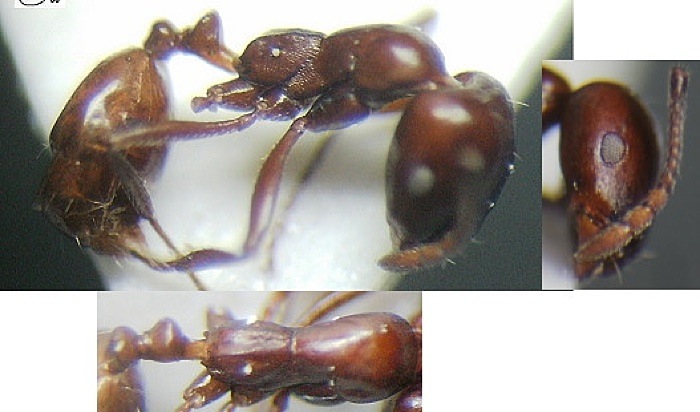 orangiae orangiae |
. |
| . | . | Promesonotum with fine but distinct sculpture, also on petiole node | . |
| . | . | 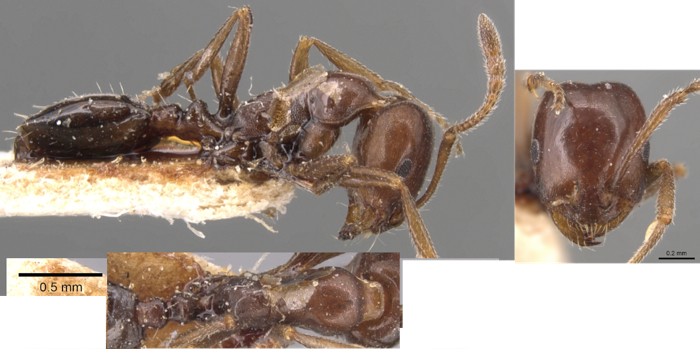 fridae
-
TL 3.1-3.2 mm; HW 0.67-0.68; SI 101-103; glossy chestnut brown - South
Africa fridae
-
TL 3.1-3.2 mm; HW 0.67-0.68; SI 101-103; glossy chestnut brown - South
Africa |
35 |
| . | . |  tchelichofi
- TL 3.8-4.0 mm; HW 0.74-0.82; SI 95-100; dark brown, gaster darker -
South Africa tchelichofi
- TL 3.8-4.0 mm; HW 0.74-0.82; SI 95-100; dark brown, gaster darker -
South Africa |
35 |
| viator-complex | 4 | Much reduced sculpturation, large eyes and long to very long scapes; elongated overall shape | |
| . | . | Without erect hairs on the alitrunk | . |
| . | . | 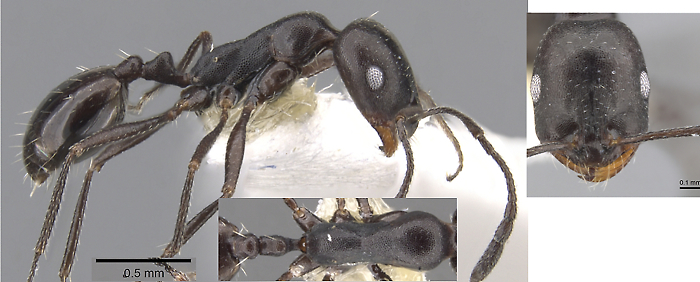 mantazenum
- relatively small eyes; TL 2.7-3.0 mm; black to blackish-brown,
mandibles yellow - Namibia mantazenum
- relatively small eyes; TL 2.7-3.0 mm; black to blackish-brown,
mandibles yellow - Namibia |
46 |
| . | . |  viator -
with extremely large eyes, 0.37-0.40 X HW, TL 3.0-3.7 mm; alitrunk
yellowish orange to reddish brown, head and gaster usually darker,
appendages dull yellow - Namibia viator -
with extremely large eyes, 0.37-0.40 X HW, TL 3.0-3.7 mm; alitrunk
yellowish orange to reddish brown, head and gaster usually darker,
appendages dull yellow - Namibia |
28 |
| . | . | 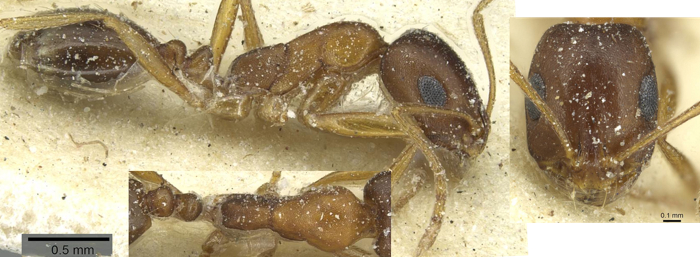 |
. |
| . | . | With erect hairs on the alitrunk | . |
| . | . |  marshi
- TL 2.7-3.2 mm; alitrunk light to dull orange, gaster dark brown to
black - Namibia marshi
- TL 2.7-3.2 mm; alitrunk light to dull orange, gaster dark brown to
black - Namibia |
16 |
| . | . | 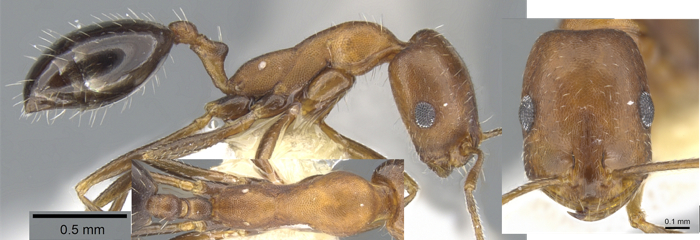 |
. |
| . | . | 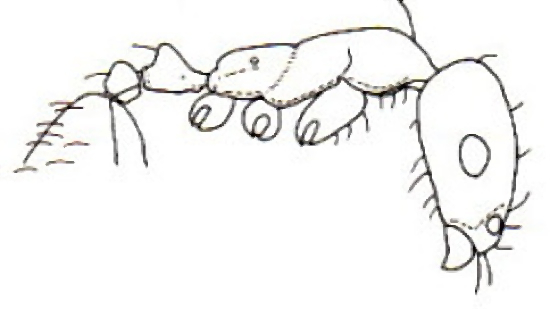 vatranum
- TL 2.7-3.0 mm; usually very dark brown - Namibia vatranum
- TL 2.7-3.0 mm; usually very dark brown - Namibia |
16 |
| . | . | 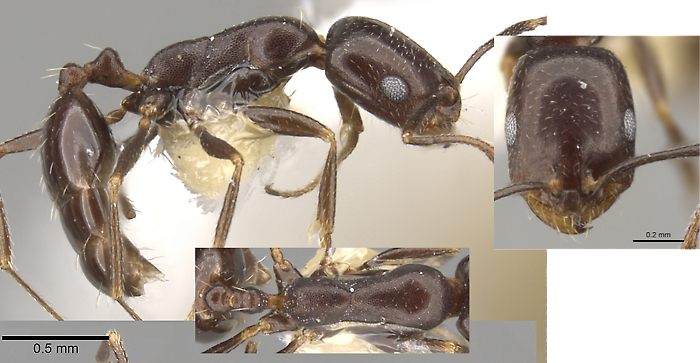 |
. |
| mediocre-complex | 6 | With reduced sculpturation and reduced pilosity (a catch-all collection) - all small species | |
| . | . | Eyes set at the mid-point of the head | . |
| . | . | 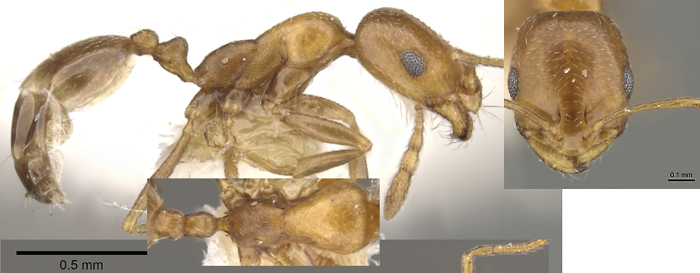 nirvanum
- petiole node with a single pair of erect hairs projecting
posteriorly; TL 2.1 mm; SI 95-100; light yellowish-brown - Namibia nirvanum
- petiole node with a single pair of erect hairs projecting
posteriorly; TL 2.1 mm; SI 95-100; light yellowish-brown - Namibia |
26 |
| . | . | 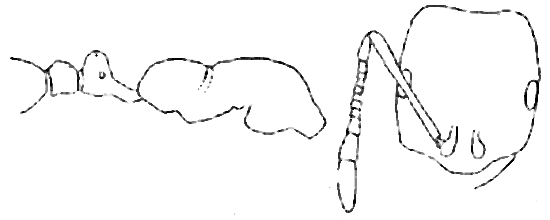 mediocre
- petiole node without erect hairs; TL 1.9-2.0 mm, SI 90-93; yellow -
Zimbabwe & South Africa mediocre
- petiole node without erect hairs; TL 1.9-2.0 mm, SI 90-93; yellow -
Zimbabwe & South Africa |
27 |
| . | . |  |
. |
| . | . | Eyes set at least slightly forward of mid-point of the head | . |
| . | . | Dorsum of head finely sculptured | . |
| . | . |  osiridis
- TL 1.7-1.9 mm; with fine shagreening on dorsum of head; uniform dull
yellow - Kenya & Gambia osiridis
- TL 1.7-1.9 mm; with fine shagreening on dorsum of head; uniform dull
yellow - Kenya & Gambia |
76 |
| . | . | 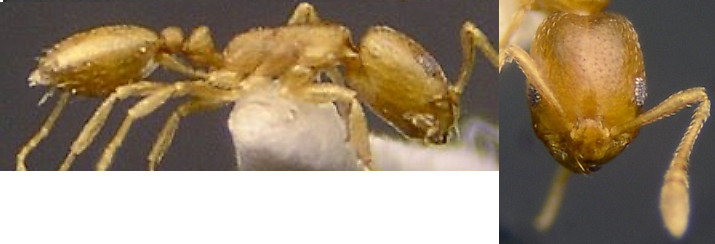 osiridis osiridis |
|
| . | . | esharre
- with relatively narrow head; TL 1.9-2.0 mm; head and gaster
blackish-brown, alitrunk lighter brown - Namibia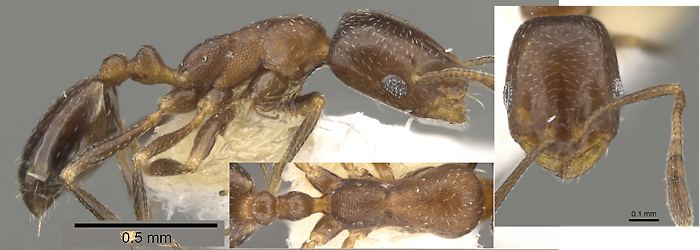 |
27 |
| . | . | Dorsum of head almost smooth | . |
| . | . | rabirium
- very faintly sculptured but pronotal dorsum reticulate to shagreened;
TL 1.7 mm, SI 92.97; yellow - Namibia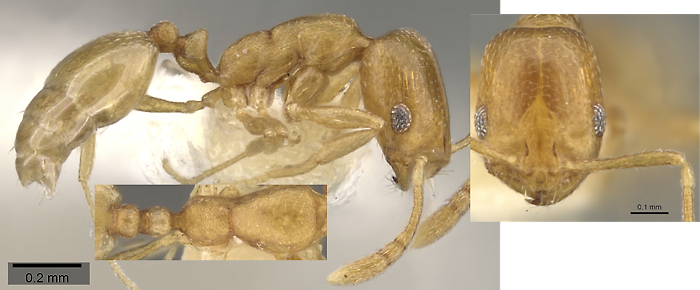 |
25 & 77 |
| . | . | 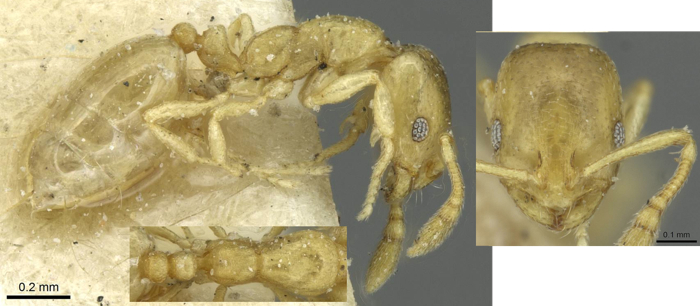 zulu
- very similar but pronotal dorsum unsculptured; TL 1.7-1.9 mm; SI
85-88 - South Africa zulu
- very similar but pronotal dorsum unsculptured; TL 1.7-1.9 mm; SI
85-88 - South Africa |
77 |
| australe-complex | 12 | Small to minute species, with fine sculpturation giving silky appearance [Curiously there are no illustrations in the literature - despite the proliferation of species by Bolton, 1987; the placement of senegalense seems likely to be wrong] | |
| . | . | senegalense - status dubious - TL 3.5-3.8 mm (Roger, 1862c) - Senegal | o |
| A | . | With numerous erect hairs on first gastral tergite in addition to apical row | . |
| . | . | Alitrunk and gaster similarly coloured not contrasting | . |
| . | . | 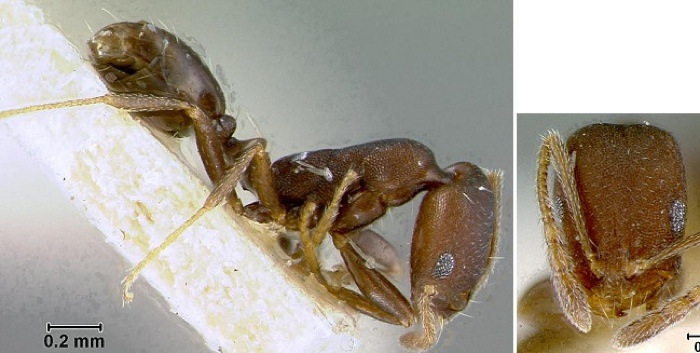 carbo -
uniformly brown; TL 2.3-2.4 mm, SI 102-107 - Ethiopia carbo -
uniformly brown; TL 2.3-2.4 mm, SI 102-107 - Ethiopia |
47 |
| . | . | 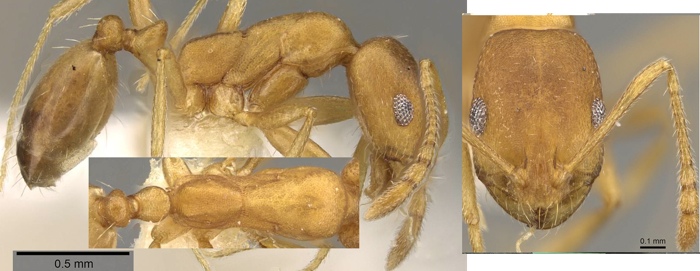 minor -
uniformly yellow; TL 2.6-2.9 mm, SI 108-116 - southwest Africa minor -
uniformly yellow; TL 2.6-2.9 mm, SI 108-116 - southwest Africa |
47 |
| . | . | Alitrunk and gaster obviously contrasting | . |
| . | . |  dakarense
- eye with 7-8 ommatidia in longest row; TL 2.2-2.3 mm; head and
alitrunk orange-yellow, gaster blackish-brown - Senegal & Gambia dakarense
- eye with 7-8 ommatidia in longest row; TL 2.2-2.3 mm; head and
alitrunk orange-yellow, gaster blackish-brown - Senegal & Gambia |
49 |
| . | . | 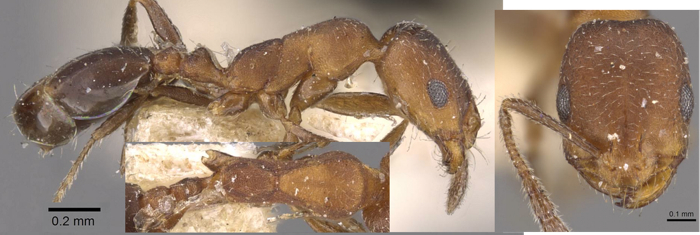 parvinode
- eye with 10 ommatidia in longest row; TL 2.2 mm; head and alitrunk
medium yellowish-brown - north-east Africa parvinode
- eye with 10 ommatidia in longest row; TL 2.2 mm; head and alitrunk
medium yellowish-brown - north-east Africa |
49 |
| B | . | With no more than 1-3 pairs of erect hairs on first gastral tergite | . |
| . | . | 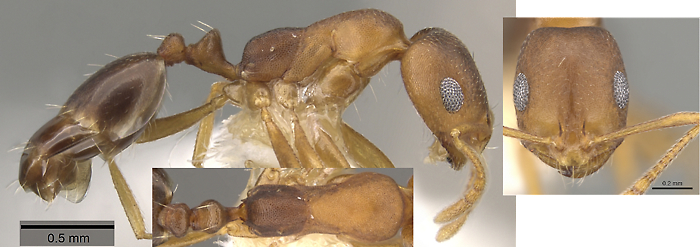 sutu
- eye with more than 10 ommatidia in the longest row; TL 2.7-3.0 mm;
head yellowish-brown, promesonotum slightly darker but remainder much
darker, gaster very dark brown - Kenya sutu
- eye with more than 10 ommatidia in the longest row; TL 2.7-3.0 mm;
head yellowish-brown, promesonotum slightly darker but remainder much
darker, gaster very dark brown - Kenya |
52 |
| . | . | Eye with 7-9 ommatidia in the longest row | . |
| . | . | 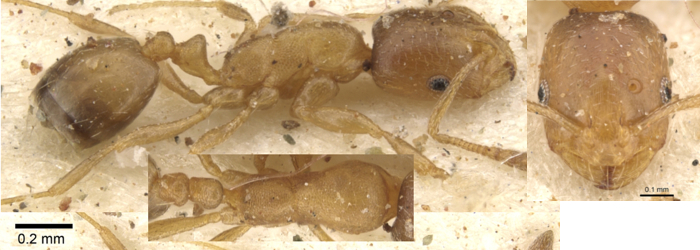 disertum
- with relatively short scapes, TL 2.0-2.2 mm SL 0.40-0.43; SI 89-93;
pale brownish yellow, gaster may be darker - Zimbabwe disertum
- with relatively short scapes, TL 2.0-2.2 mm SL 0.40-0.43; SI 89-93;
pale brownish yellow, gaster may be darker - Zimbabwe |
54 |
| . | . | Scapes with SL 0.47-0.57, SI 100-110 | . |
| . | . | Head strongly sculptured, shagreened, dull & opaque | . |
| . | . | 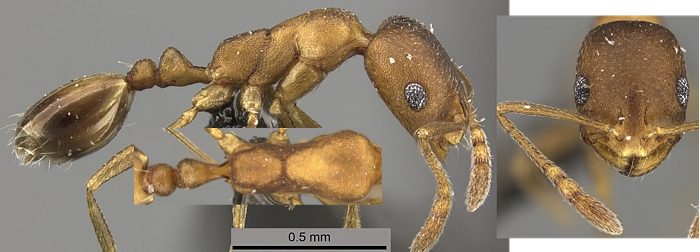 damarense
- dorsum of head without erect hairs; TL 2.2-2.8 mm; eyes 0.27-0.31 X
HW; light to medium brown - southern Africa damarense
- dorsum of head without erect hairs; TL 2.2-2.8 mm; eyes 0.27-0.31 X
HW; light to medium brown - southern Africa |
23 & 56 |
| . | . | opacior
- dorsum of head with 2 pairs of erect hairs behind level of frontal
lobes; TL 2.2-2.4 mm, eyes 0.24-0.26 X HW; dull light brown, gaster
much darker - Namibia & Botswana |
56 |
| . | . | Head very weakly sculptured, near smooth and weakly shining | . |
| . | . | termitarium
- TL 2.5-2.6 mm; entirely yellow - Botswana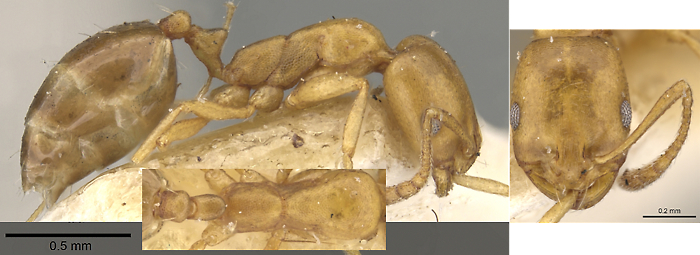 |
57 |
| . | . | Head & alitrunk medium brown, gaster dark brown | . |
| . | . | 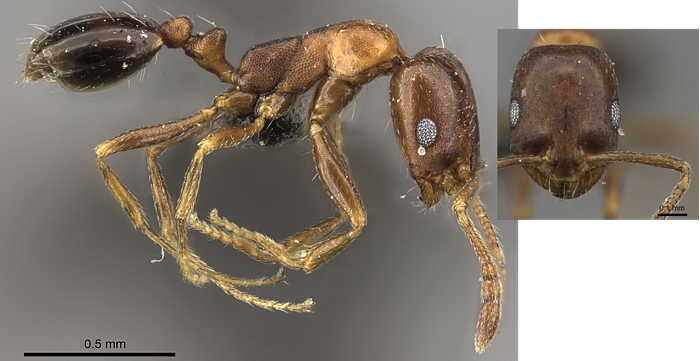 anceps
-
pronotal dorsum finely shagreened, with rough appearance but mesonotum
contrasting reticulo-punctate; TL 2.5-2.6 mm, HW 0.47, SL 0.47 - South
Africa anceps
-
pronotal dorsum finely shagreened, with rough appearance but mesonotum
contrasting reticulo-punctate; TL 2.5-2.6 mm, HW 0.47, SL 0.47 - South
Africa |
58 |
| . | . | 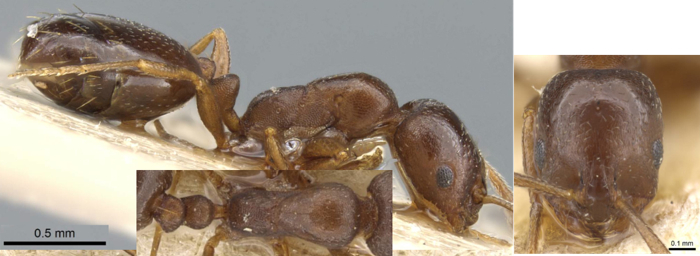 australe
- pronotal dorsum finely reticulate and mesonotum more strongly so but
not contrasting; TL 2.5-2.6 mm, HW 0.50-0.52 SL 0.50-0.54 - South Africa australe
- pronotal dorsum finely reticulate and mesonotum more strongly so but
not contrasting; TL 2.5-2.6 mm, HW 0.50-0.52 SL 0.50-0.54 - South Africa |
58 |
| Propodeal dorsum unsculptured | |||
| monomorium-group (Monomorium) |
69 | Antennae with 11-12 segments; alitrunk dorsum with standing hairs, at least on pronotal humeri | |
| . | Antennae
12-segmented |
||
| . | Antennae 11-segmented | ||
| . | Scapes reaching or surpassing the occiput, SI 95-102 (otherwise grouped with species with 12-segmented antennae) | ||
| . | . | 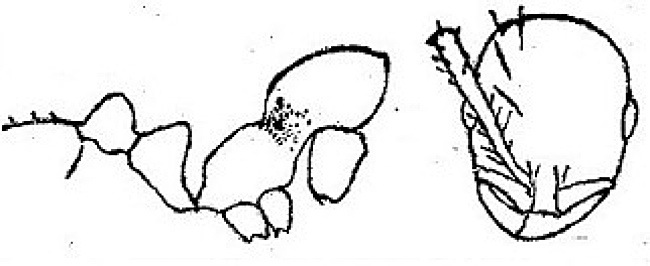 strangulatum
- TL 1.8-2.0 mm; all over dark brown, except for contrasting yellow
appendages - West Africa & Congo Basin (in strangulatum-complex,
Bolton, 1987) strangulatum
- TL 1.8-2.0 mm; all over dark brown, except for contrasting yellow
appendages - West Africa & Congo Basin (in strangulatum-complex,
Bolton, 1987) |
146 |
| . | . | 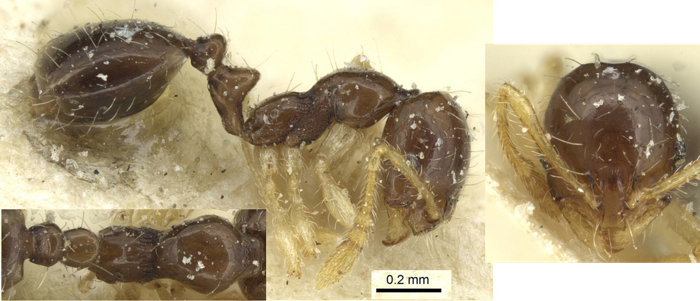 strangulatum strangulatum |
. |
| . | . | 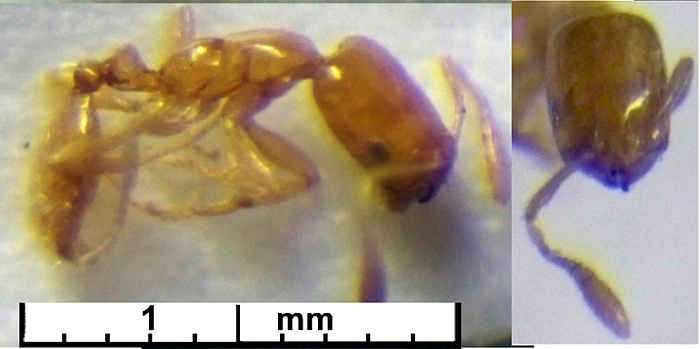 clavicorne
- antennae 11-segmented; TL 1.4 mm; head an elongated rectangle; eyes
set forward of midline of head; yellow or pale testaceous -
Extra-limital, plus Sudan and Senegal clavicorne
- antennae 11-segmented; TL 1.4 mm; head an elongated rectangle; eyes
set forward of midline of head; yellow or pale testaceous -
Extra-limital, plus Sudan and Senegal |
not in key |
| . | Scapes not reaching occiput SI usually < 95 | ||
| . | 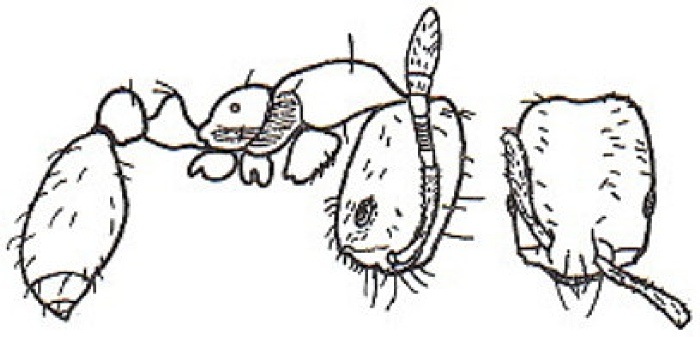 Large relatively high
postpetiole, convex propodeum - bequaerti-complex
- Large relatively high
postpetiole, convex propodeum - bequaerti-complex
- |
||
| . |  Eyes reduced with a
ring of ommatidia enclosing a single
longitudinal row of 2-4 ommatidia; propodeal profile in most a shallow
smooth curve - boerorum-complex; Lampyromyrmex
sub-complex - Eyes reduced with a
ring of ommatidia enclosing a single
longitudinal row of 2-4 ommatidia; propodeal profile in most a shallow
smooth curve - boerorum-complex; Lampyromyrmex
sub-complex - |
||
| bequaerti-complex | 3 | Large postpetiole which is almost as voluminous as petiole; propodeum convex | |
| . | . |  rosae -
blackish-brown to jet black; TL 1.6-2.0 mm - West Africa rosae -
blackish-brown to jet black; TL 1.6-2.0 mm - West Africa |
150 |
| . | . |  rosae rosae |
. |
| . | . | 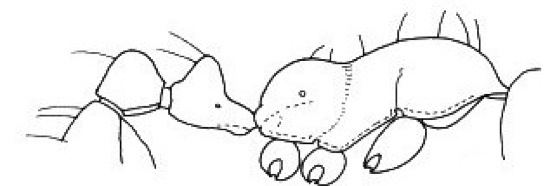 bequaerti
- light glossy brown; in dorsal view both petiole and postpetiole
longer than wide; TL 1.9 mm - Zaïre bequaerti
- light glossy brown; in dorsal view both petiole and postpetiole
longer than wide; TL 1.9 mm - Zaïre |
151 |
| . | . |  bequaerti bequaerti |
. |
| . | . |  pulchrum
- head and alitrunk glossy dull yellow to pale brown, gaster darker; in
dorsal view both petiole and postpetiole shorter than wide; TL 1.7-1.9
mm - Zimbabwe pulchrum
- head and alitrunk glossy dull yellow to pale brown, gaster darker; in
dorsal view both petiole and postpetiole shorter than wide; TL 1.7-1.9
mm - Zimbabwe |
151 |
| . | . |  |
. |
| boerorum-complex
- sub-complex A (Lampyromyrmex) |
7 | Convenience lumping of other species with 11-segmented antennae; eyes reduced with a ring of ommatidia enclosing a single longitudinal row of 2-4 ommatidia; propodeal profile in most a shallow smooth curve | |
| . | . | 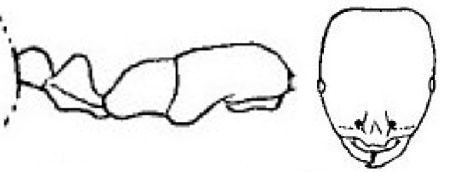 guillarmodi
- alitrunk dorsum without erect hairs; TL 1.6-1.7 mm; glossy light
medium brown - Lesotho guillarmodi
- alitrunk dorsum without erect hairs; TL 1.6-1.7 mm; glossy light
medium brown - Lesotho |
145 |
| . | . | Alitrunk dorsum with erect hairs | . |
| . | . |  spectrum
- distinctively coloured with white legs contrasting with glossy dark
brown body; TL 1.2-1.3 mm - Gabon spectrum
- distinctively coloured with white legs contrasting with glossy dark
brown body; TL 1.2-1.3 mm - Gabon |
147 |
| . | . | Pronotum dorsum anteriorly with a single pair of long erect hairs | . |
| . | . |  taedium
- larger, TL 1.6-1.7 mm, dark brown - South Africa taedium
- larger, TL 1.6-1.7 mm, dark brown - South Africa |
153 |
| . | . | 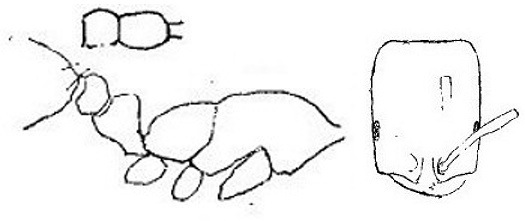 mictilis
- TL 1.2-1.3 mm; dull yellow - eastern & southern Africa - note
Bolton (1987: 320) separated this as having the head with a noticeably
depressed profile (both upper and lower surfaces) - the head of the
type specimen (Antweb photo) is not depressed! Fresh specimens have the
posterior half of the gaster dark contrasting with the otherwise quite
bright yellow of the head and body mictilis
- TL 1.2-1.3 mm; dull yellow - eastern & southern Africa - note
Bolton (1987: 320) separated this as having the head with a noticeably
depressed profile (both upper and lower surfaces) - the head of the
type specimen (Antweb photo) is not depressed! Fresh specimens have the
posterior half of the gaster dark contrasting with the otherwise quite
bright yellow of the head and body |
154 |
| . | . | 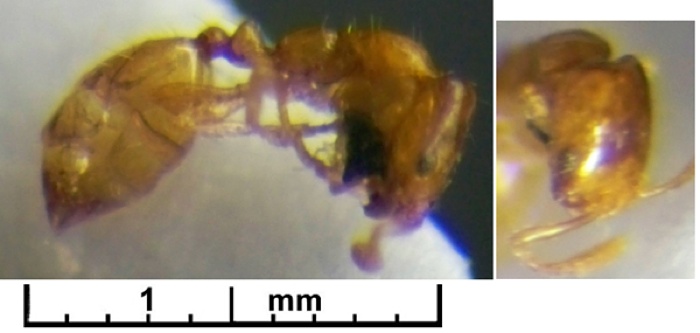 mictilis mictilis |
|
| . | 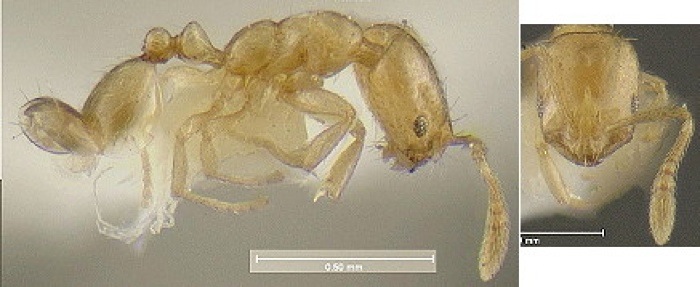 fastidium
- TL 1.4 mm; uniform dull pale yellow - South Africa - possible junior
synonym of mictilis fastidium
- TL 1.4 mm; uniform dull pale yellow - South Africa - possible junior
synonym of mictilis |
154 | |
| . | . | Pronotum dorsum with two pairs of long erect hairs anteriorly | . |
| . | . |  exiguum
- anterior half of pronotum dorsum lacking a clump of 4 or more erect
hairs; petiole short with a short anterior ventral process; TL 1.5-1.7
mm; variable clear yellow to dark brown (possibly a mixture of similar
species) - Pan-African forests exiguum
- anterior half of pronotum dorsum lacking a clump of 4 or more erect
hairs; petiole short with a short anterior ventral process; TL 1.5-1.7
mm; variable clear yellow to dark brown (possibly a mixture of similar
species) - Pan-African forests |
155 |
| . | . | 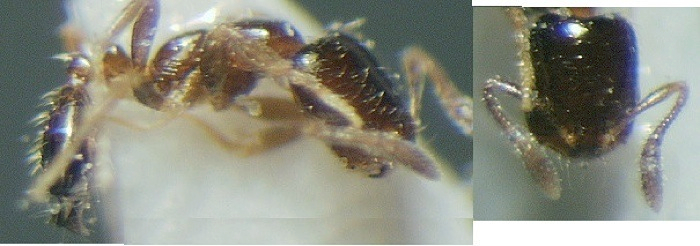 exiguum
type form exiguum
type form |
. |
| . | . | 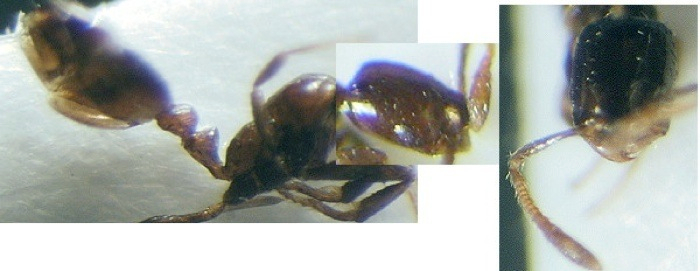 exiguum minutissimum
form exiguum minutissimum
form |
. |
| . | . | 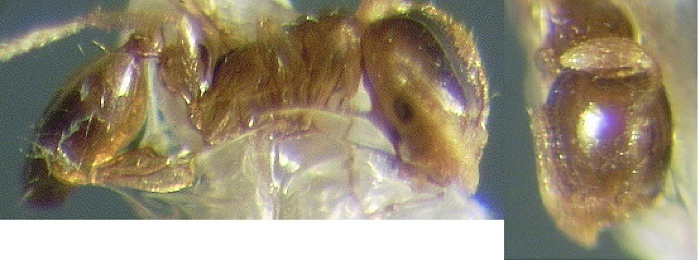 exiguum faurei
form exiguum faurei
form |
. |
| . | . |  vaguum -
anterior half of pronotum with a clump of 4 or more erect hairs; TL
1.3-1.4 mm CI 76-82; eye near circular, EI 20-23; dull yellow to medium
brown (possibly a mixture of similar
species) - widely distributed vaguum -
anterior half of pronotum with a clump of 4 or more erect hairs; TL
1.3-1.4 mm CI 76-82; eye near circular, EI 20-23; dull yellow to medium
brown (possibly a mixture of similar
species) - widely distributed |
155 |
| . | . |  vaguum vaguum |
. |
| . | . | 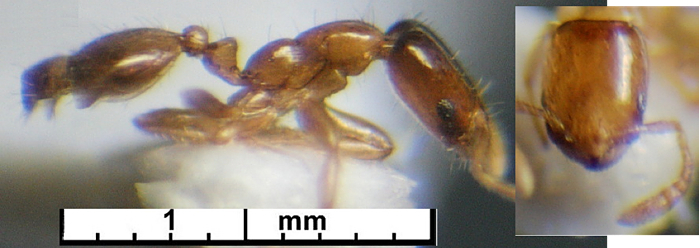 atomum -
promesonotum profile more convex; erect hairs appear finer; TL
1.2-1.3 mm CI 76; eye longitudinally ovoid, EI 17; yellow to reddish
yellow; entirely smooth and very shiny - Egypt across South Asia atomum -
promesonotum profile more convex; erect hairs appear finer; TL
1.2-1.3 mm CI 76; eye longitudinally ovoid, EI 17; yellow to reddish
yellow; entirely smooth and very shiny - Egypt across South Asia |
extralimital |
| . | Antennae 12-segmented | ||
| . | Petiole
node in profile a high narrow cone |
||
| . | Petiole node in profile a low cone | ||
| . | 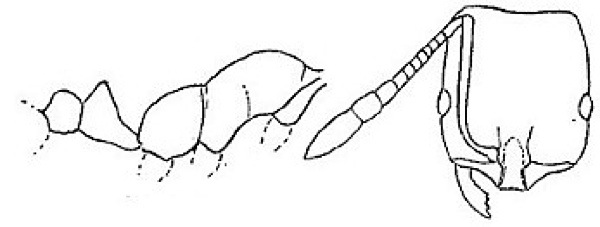 Clypeal carinae sharp
and close together, eyes round or
near round; scapes relatively long SI 95-110 - schultzei-complex
- Clypeal carinae sharp
and close together, eyes round or
near round; scapes relatively long SI 95-110 - schultzei-complex
- |
||
| . | 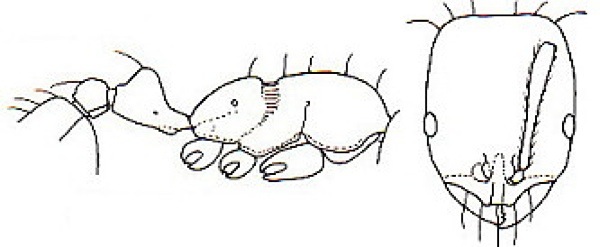 Like schultzei-complex
but eyes more elongate and
scapes relatively short, failing to reach the occiput (just reach in binatu)
- rhopalocerum-complex - Like schultzei-complex
but eyes more elongate and
scapes relatively short, failing to reach the occiput (just reach in binatu)
- rhopalocerum-complex - |
||
| . |  Sharp but
well-separated clypeal carinae, without anterior
teeth; scapes surpass occiput - strangulatum-complex - Sharp but
well-separated clypeal carinae, without anterior
teeth; scapes surpass occiput - strangulatum-complex - |
||
| . | 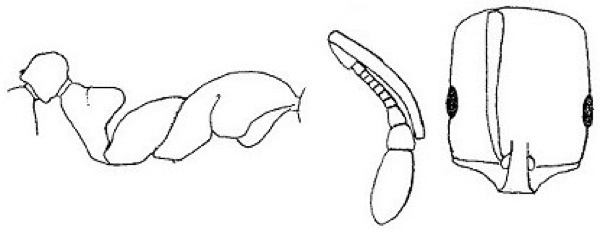 Eyes smaller and set
well forward; petiole subconical - leopoldinum-complex
[Note - leopoldinum itself is a junior synonym of madecassum
according to Hetterick (2002) - Eyes smaller and set
well forward; petiole subconical - leopoldinum-complex
[Note - leopoldinum itself is a junior synonym of madecassum
according to Hetterick (2002) - |
||
| Petiole node in profile a high narrow cone | |||
| . | Large
size, small eyes, short scapes & very dense pilosity - iyenasu-complex
(single species) - |
||
| . | 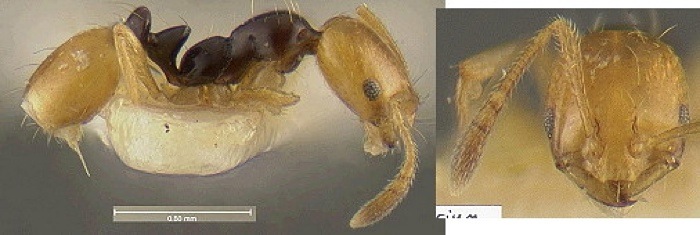 Distinctive high
petiole node; scapes not reaching
occipitum; clypeus with sharp carinae set close together and projecting
at the anterior clypeal margin - altinode-complex - Distinctive high
petiole node; scapes not reaching
occipitum; clypeus with sharp carinae set close together and projecting
at the anterior clypeal margin - altinode-complex - |
||
| . | 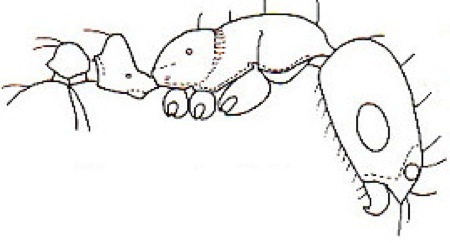 Large eyes at least
0.30 X HW and set well forward;
petiole subconical in profile - katir-complex - Large eyes at least
0.30 X HW and set well forward;
petiole subconical in profile - katir-complex - |
||
| . | 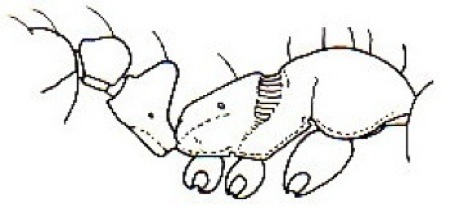 Petiole node high,
narrow or cuneate in profile, petiole
with pronounced antero-ventral process - malatu-complex - Petiole node high,
narrow or cuneate in profile, petiole
with pronounced antero-ventral process - malatu-complex - |
||
| . | Residual
"convenience" lumping of 15 species - boerorum-complex - |
||
| . | . | 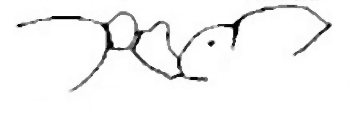 monomorium
- with thick erect hairs all over; TL 1.5-1.7 mm; piceous, very shiny,
smooth - extra-limital and included for comparison monomorium
- with thick erect hairs all over; TL 1.5-1.7 mm; piceous, very shiny,
smooth - extra-limital and included for comparison |
not in key |
| . |
. |
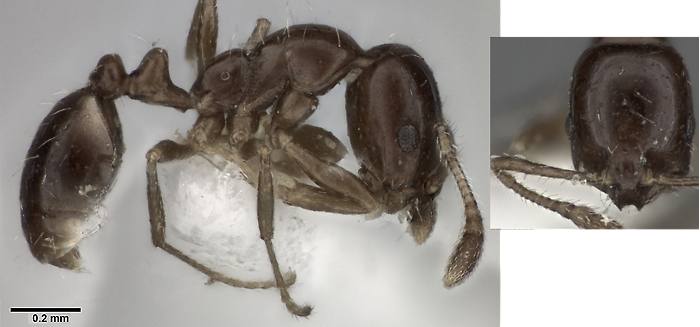 monomorium monomorium |
. |
| altinode-complex | 9 | Distinctive high petiole node; scapes not reaching occipitum | |
| . | . |  mirandum
- strikingly bicoloured, clear yellow except for alitrunk, petiole and
postpetiole which are black or blackish-brown; TL 1.8-1.9 mm - Kenya mirandum
- strikingly bicoloured, clear yellow except for alitrunk, petiole and
postpetiole which are black or blackish-brown; TL 1.8-1.9 mm - Kenya |
99 |
| . | . | Various colours but not strikingly bicoloured | . |
| . | . | Propodeal spiracle a conspicuous circle | . |
| . | . |  occidentale
- anterior clypeal margin with a carinae extended to form a pair of
elongate teeth; TL 1.8-2.1 mm; dark brown, gaster often darker - West
Africa occidentale
- anterior clypeal margin with a carinae extended to form a pair of
elongate teeth; TL 1.8-2.1 mm; dark brown, gaster often darker - West
Africa |
114 |
| . | . | 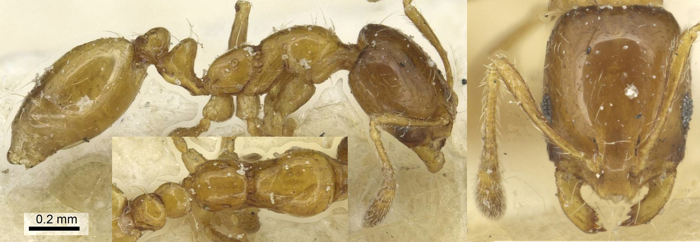 captator
- anterior clypeal margin with carinae forming no more than denticles;
TL 1.8-1.9 mm; glossy dull yellow, head slightly darker than alitrunk -
Congo Basin captator
- anterior clypeal margin with carinae forming no more than denticles;
TL 1.8-1.9 mm; glossy dull yellow, head slightly darker than alitrunk -
Congo Basin |
117 |
| . | . | Propodeum spiracle a small to minute circular opening | . |
| . | . |  vonatu -
both petiole and postpetiole with a sharp margin around sides and
dorsum; TL 2.0 mm; glossy black - Ghana & Gambia vonatu -
both petiole and postpetiole with a sharp margin around sides and
dorsum; TL 2.0 mm; glossy black - Ghana & Gambia |
119 |
| . | . | Petiole and postpetiole not sharp edged | . |
| . | . | 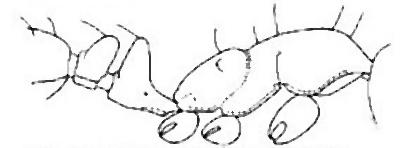 angustinode
- propodeum with spiracle almost at top of sides (each visible from
above as at the apex of a tubercle); prodeum dorsum and declivity with
the transition a smoothly curve; TL 1.9-2.0 mm; light brownish yellow,
head and gaster slightly darker than alitrunk - Zaïre angustinode
- propodeum with spiracle almost at top of sides (each visible from
above as at the apex of a tubercle); prodeum dorsum and declivity with
the transition a smoothly curve; TL 1.9-2.0 mm; light brownish yellow,
head and gaster slightly darker than alitrunk - Zaïre |
129 |
| . | . |  angustinode angustinode |
. |
| . | . | Propodeum with spiracles set lower and not on tubercles; transition from dorsum to declivity a rounded angle | . |
| . | . | 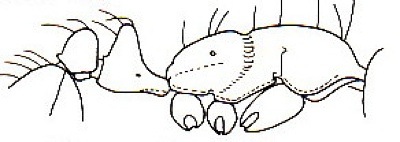 fugelanum
- with large eyes, 0.26-0.28 x HW, and a minute propodeal spiracle;
yellow; TL 1.8 mm - Botswana fugelanum
- with large eyes, 0.26-0.28 x HW, and a minute propodeal spiracle;
yellow; TL 1.8 mm - Botswana |
130 |
| . | . | 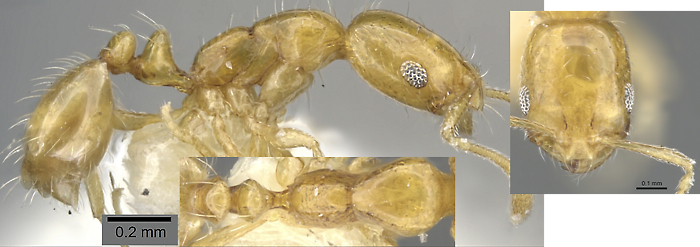 |
. |
| . | . | Eyes smaller, maximum 0.24 X HW, and propodeal spiracle small but a distinct circle | . |
| . | 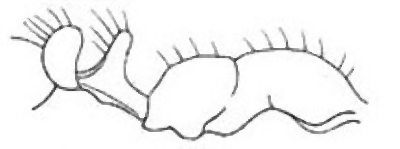 arnoldi
- with relatively long scapes, SI 95-98, and small eyes, 0.20-0.22 X
HW; petiole narrowly crested; glossy yellow to light brownish-yellow;
TL 2.0-2.1 mm - Zimbabwe arnoldi
- with relatively long scapes, SI 95-98, and small eyes, 0.20-0.22 X
HW; petiole narrowly crested; glossy yellow to light brownish-yellow;
TL 2.0-2.1 mm - Zimbabwe |
131 | |
| . | . | 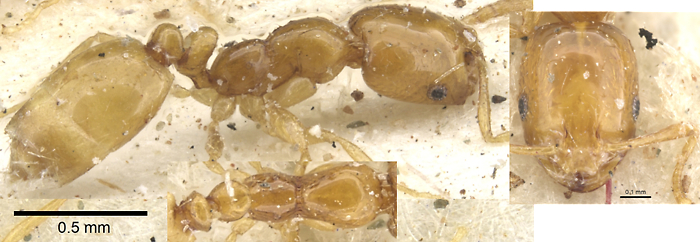 |
. |
| . | . | Scapes relatively short, SI 87-95, and eyes 0.22-0.24 X HW | . |
| . | . | 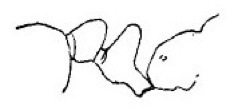 altinode
- promesonotum with 5 pairs of erect hairs; TL 1.7 mm; yellow - Congo
Basin altinode
- promesonotum with 5 pairs of erect hairs; TL 1.7 mm; yellow - Congo
Basin |
132 |
| . | . |  altinode altinode |
. |
| . | . | 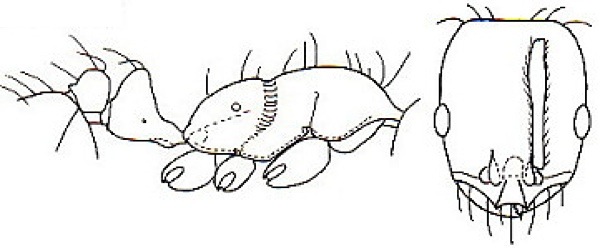 tynsorum
- promesonotum with 7-8 pairs of erect hairs; TL 2.1-2.3 mm; yellow -
Angola & Gabon tynsorum
- promesonotum with 7-8 pairs of erect hairs; TL 2.1-2.3 mm; yellow -
Angola & Gabon |
132 |
| . | . | 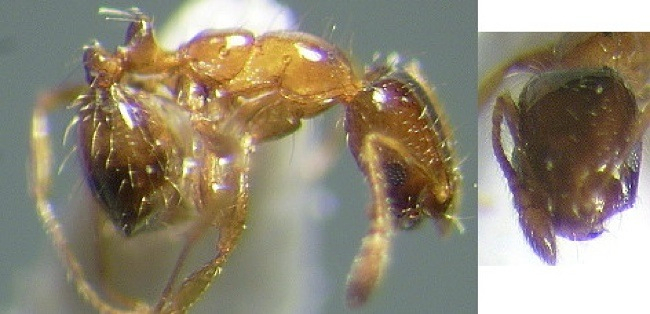 tynsorum tynsorum |
. |
| katir-complex | 4 | Large eyes at least 0.30 X HW set well forward; petiole subconical in profile | |
| . | . | Uniform dark brown to blackish | . |
| . | . | 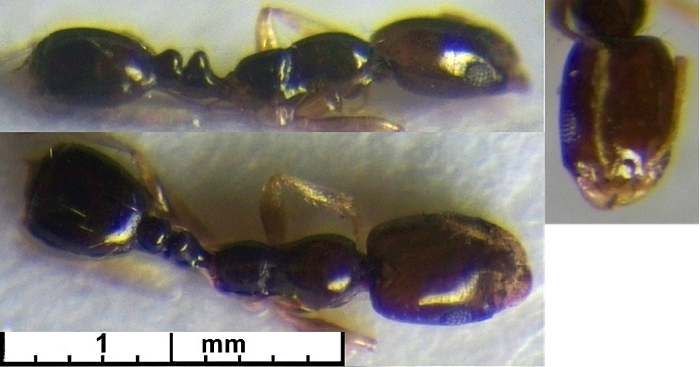 balathir
- anterior alitrunk with 8-10 erect hairs; longest hairs on first
gastral tergite longer than maximum diameter of the eye; TL 2.3 mm;
glossy dark brown appendages yellow - Burkina Faso & Senegal balathir
- anterior alitrunk with 8-10 erect hairs; longest hairs on first
gastral tergite longer than maximum diameter of the eye; TL 2.3 mm;
glossy dark brown appendages yellow - Burkina Faso & SenegalSenegal workers smaller than type description. |
122 |
| . | . | 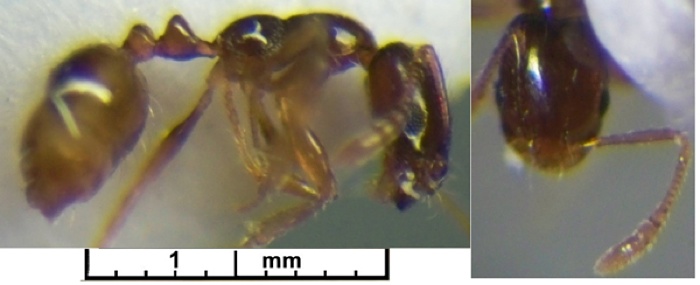 manir
-
anterior alitrunk with 3-4 pairs of erect hairs; longest hairs on first
gastral tergite shorter than maximum diameter of the eye; TL 1.8 mm;
glossy dark brown appendages lighter - Kenya & Sudan manir
-
anterior alitrunk with 3-4 pairs of erect hairs; longest hairs on first
gastral tergite shorter than maximum diameter of the eye; TL 1.8 mm;
glossy dark brown appendages lighter - Kenya & Sudan |
122 |
| . | . | Uniform yellow to light brownish yellow | . |
| . | . | 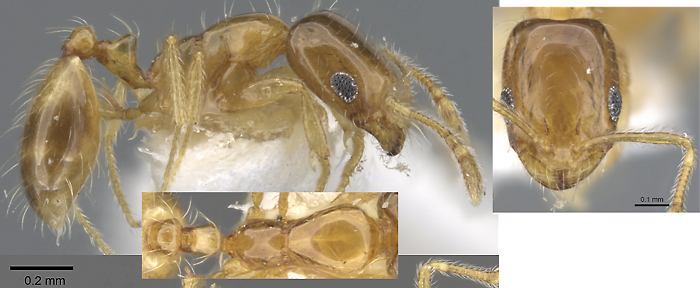 holothir
- alitrunk with more than 3 pairs of erect hairs; TL 1.8-1.9 mm - Kenya holothir
- alitrunk with more than 3 pairs of erect hairs; TL 1.8-1.9 mm - Kenya |
123 |
| . | . |  katir
- alitrunk with one pair of erect hairs on each segment; TL 1.7-1.9 mm
- Namibia katir
- alitrunk with one pair of erect hairs on each segment; TL 1.7-1.9 mm
- Namibia |
123 |
| . | . | 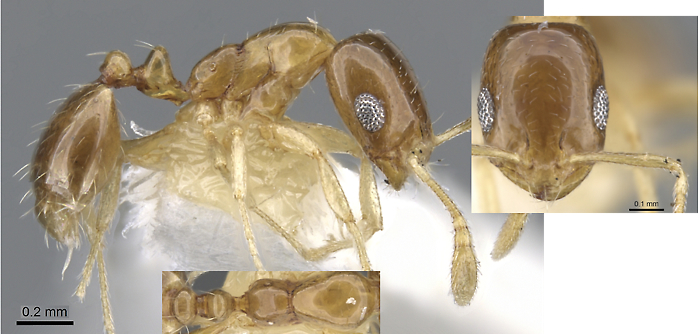 |
. |
| leopoldinum-complex | 6 | Eyes smaller and set well forward; petiole subconical | |
| . | . | Propodeal spiracle a conspicuously large circle | .. |
| . | . | 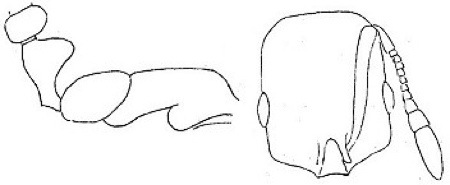 lene
- head and body yellow; dorsal alitrunk with numerous erect hairs; TL
1.8-2.1 mm - Tanzania, Botswana, Zimbabwe lene
- head and body yellow; dorsal alitrunk with numerous erect hairs; TL
1.8-2.1 mm - Tanzania, Botswana, Zimbabwe |
117 |
| . | . |  |
. |
| . | . |  borlei
- head and body brown; dorsal alitrunk with only 4 pairs of erect
hairs, 3 pairs being on the promesonotum; TL 1.9-2.4 mm - Congo &
Angola borlei
- head and body brown; dorsal alitrunk with only 4 pairs of erect
hairs, 3 pairs being on the promesonotum; TL 1.9-2.4 mm - Congo &
Angola |
118 |
| . | . | 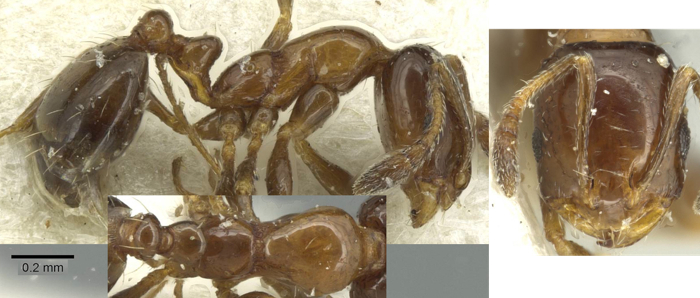 borlei borlei |
. |
| . | . | 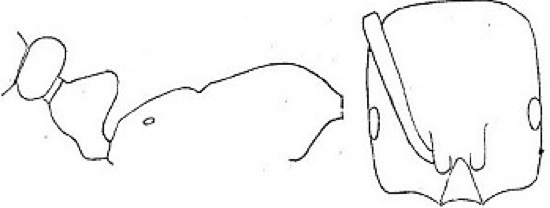 madecassum
[j.syn. leopoldinum] - head and body brown; whole of head and
body with many erect hairs; TL 1.9-2.4 mm - Sudan, Kenya, Zaïre;
Madagascar madecassum
[j.syn. leopoldinum] - head and body brown; whole of head and
body with many erect hairs; TL 1.9-2.4 mm - Sudan, Kenya, Zaïre;
Madagascar |
118 |
| . | . | 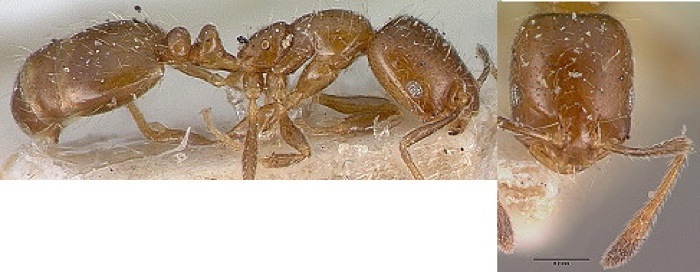 madecassum madecassum |
. |
| . | . | Propodeal spiracle a small pinhole | . |
| . | . | Anterior clypeal margin concave with projecting lateral denticles | . |
| . | . | rastractum
- promesonotal dorsum with 6-7 pairs of erect hairs; eye diameter max
0.27 X HW; TL 1.9 mm; yellow - Kenya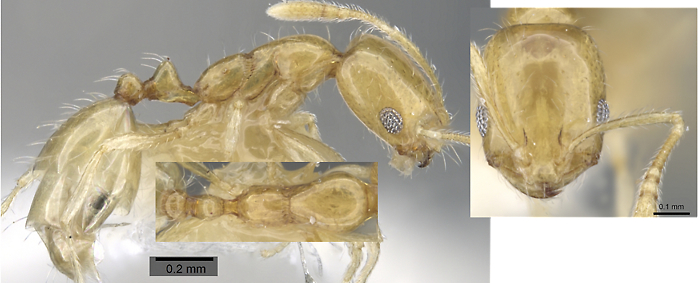 |
128 |
| . | . |  springvalense
- promesonotal dorsum with 3-4 pairs of erect hairs; eye diameter max
0.21-0.23 X HW; TL 2.0-2.1 mm; alitrunk yellow, head and gaster
brownish - Zimbabwe springvalense
- promesonotal dorsum with 3-4 pairs of erect hairs; eye diameter max
0.21-0.23 X HW; TL 2.0-2.1 mm; alitrunk yellow, head and gaster
brownish - Zimbabwe |
128 |
| . | . | Anterior clypeal margin near straight without projecting denticles | . |
| . | . |  pallidipes
- TL 1.5 mm; promesonotum with 5 pairs of erect hairs; uniform brown
(Bolton) plus paler appendages (Forel) - Eritrea & Tanzania pallidipes
- TL 1.5 mm; promesonotum with 5 pairs of erect hairs; uniform brown
(Bolton) plus paler appendages (Forel) - Eritrea & Tanzania |
142 |
| . | . | 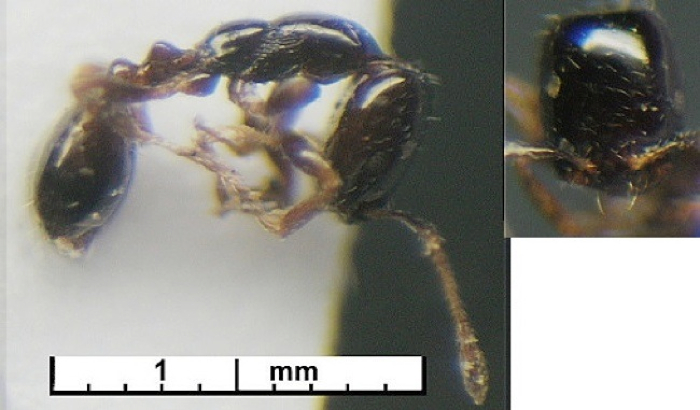 pallidipes pallidipes |
. |
| schultzei-complex | 10 | Clypeal carinae sharp and close together, eyes round or near round | |
| . | . | Scapes reaching or slightly surpassing occiput | . |
| . | . | 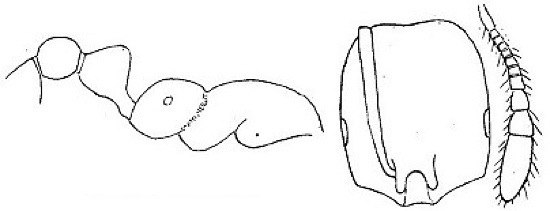 fasciatum
- TL 1.8 mm; clear reddish yellow, gaster ochraceous with a transverse
dark band - Kenya & Tanzania -status confirmed fasciatum
- TL 1.8 mm; clear reddish yellow, gaster ochraceous with a transverse
dark band - Kenya & Tanzania -status confirmed |
o not in key |
| . | . | 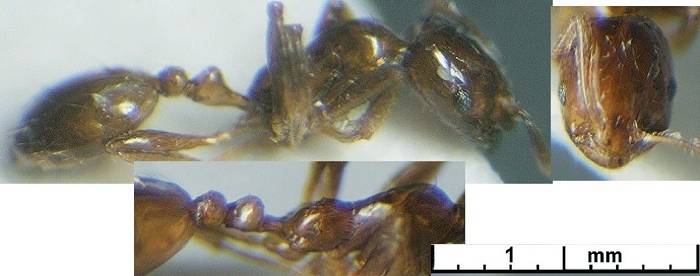 fasciatum fasciatum |
. |
| . | . |  speluncarum
- scapes slightly surpass occipitum, SI 106-107; TL 1.6-1.7 mm; uniform
pale yellow - Kenya & Tanzania speluncarum
- scapes slightly surpass occipitum, SI 106-107; TL 1.6-1.7 mm; uniform
pale yellow - Kenya & Tanzania |
103 |
| . | . | 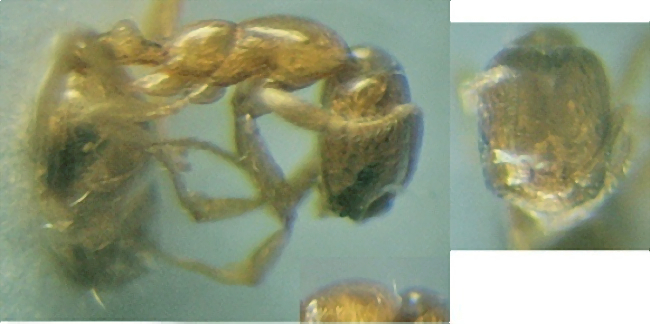 speluncarum speluncarum |
|
| . | . | Scapes not reaching occiput | . |
| . | . | In profile alitrunk with a very narrow metanotal suture that has only inconspicuous cross ribbing; propodeal spiracle minute | . |
| . | . |  bevisi -
promesonotum with 8 + pairs of erect hairs; dingy light brown; TL
2.4-2.6 mm - Lesotho bevisi -
promesonotum with 8 + pairs of erect hairs; dingy light brown; TL
2.4-2.6 mm - Lesotho |
107 |
| . | . | 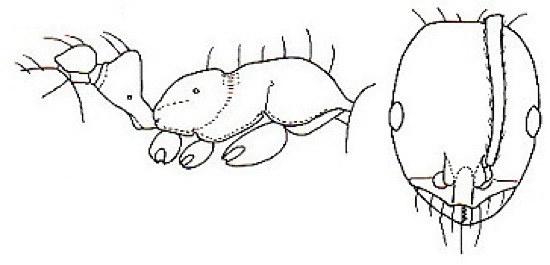 excensurae
- promesonotum with 4-6 pairs of erect hairs; yellow; eyes smallish
0.20-0.23 X HW; SI 104-110; TL 1.9-2.2 mm - South Africa excensurae
- promesonotum with 4-6 pairs of erect hairs; yellow; eyes smallish
0.20-0.23 X HW; SI 104-110; TL 1.9-2.2 mm - South Africa |
108 |
| . | . |  |
. |
| . | . | 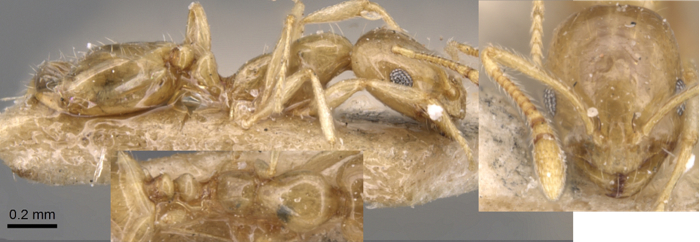 schultzei
-
promesonotum with 4-6 pairs of erect hairs; yellow; eyes larger
0.24-0.27 X HW and scapes shorter SI 97-102; TL 2.0-2.2 mm - southern
Africa schultzei
-
promesonotum with 4-6 pairs of erect hairs; yellow; eyes larger
0.24-0.27 X HW and scapes shorter SI 97-102; TL 2.0-2.2 mm - southern
Africa |
108 |
| . | . | In profile alitrunk with a broad metanotal suture that has conspicuous cross ribbing; propodeal spiracle large and conspicuous | . |
| . | . | 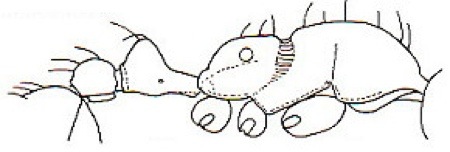 kineti
- propodeum with a flat to slightly concave dorsum with weakly flanged
edges; TL 2.2-2.4 mm; dull yellow to brownish-yellow (dark brown,
Weber) - South Sudan kineti
- propodeum with a flat to slightly concave dorsum with weakly flanged
edges; TL 2.2-2.4 mm; dull yellow to brownish-yellow (dark brown,
Weber) - South Sudan |
109 |
| . | . |  |
. |
| . | . | Propodeum dorsum transversely convex or if flat without flanged borders | . |
| . | . | Promesonotal dorsum with 4-6 pairs of erect hairs | . |
| . | . | 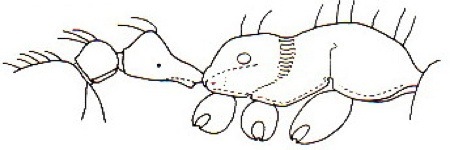 arboreum
- metanotal suture shallowly impressed and only moderately broad;
propodeum profile with flat area; TL 2.1-2.3 mm; dull yellow, occiput
and posterior gaster darker - South Sudan & Kenya (no type
photographs available) arboreum
- metanotal suture shallowly impressed and only moderately broad;
propodeum profile with flat area; TL 2.1-2.3 mm; dull yellow, occiput
and posterior gaster darker - South Sudan & Kenya (no type
photographs available) |
111 |
| . | . |  crawleyi
- metanotal suture unusually wide and prodeum dorsum uniformly convex;
TL 2.3-2.4 mm; yellow with occiput and posterior gaster darker -
Ethiopia and Congo crawleyi
- metanotal suture unusually wide and prodeum dorsum uniformly convex;
TL 2.3-2.4 mm; yellow with occiput and posterior gaster darker -
Ethiopia and Congo |
111 |
| . | . | 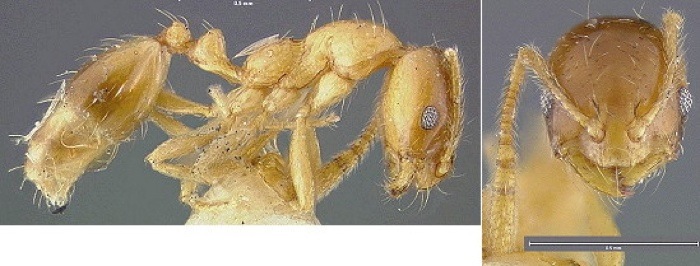 crawleyi crawleyi |
. |
| . | . | Promesonotal dorsum with 8 or more pairs of erect hairs | . |
| . | . | 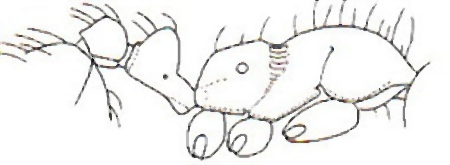 firmum
- petiole with a conspicous anterior ventral lobe; sides of head with
all hairs decumbent to appressed; TL 2.6-2.8 mm; yellow - Zimbabwe firmum
- petiole with a conspicous anterior ventral lobe; sides of head with
all hairs decumbent to appressed; TL 2.6-2.8 mm; yellow - Zimbabwe |
112 |
| . | . |  |
112 |
| . | . | 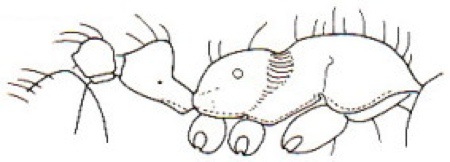 vecte
- petiole with anterior ventral process a low ridge; sides of head with
hairs semi-erect; TL 2.0-2.4 mm; yellow with a darker band apically on
first gastral tergite - Zimbabwe & Rwanda vecte
- petiole with anterior ventral process a low ridge; sides of head with
hairs semi-erect; TL 2.0-2.4 mm; yellow with a darker band apically on
first gastral tergite - Zimbabwe & Rwanda |
112 |
| . | . | 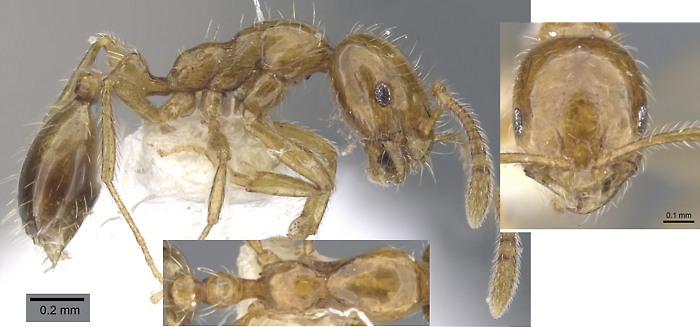 |
. |
| rhopalocerum-complex | 5 | Like schultzei-complex but eyes more elongate and scapes relatively short | |
| . | . | 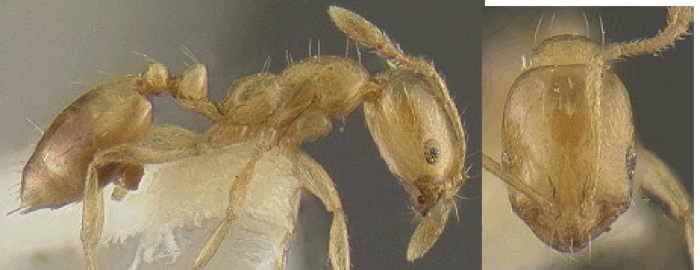 termitobium
binatu - scapes just surpassing the occiput, SI 100-105; TL
1.9-2.0 mm; yellow, gaster slightly darker - Zimbabwe termitobium
binatu - scapes just surpassing the occiput, SI 100-105; TL
1.9-2.0 mm; yellow, gaster slightly darker - Zimbabwe |
101 |
| . | . | Scapes not reaching the occiput | . |
| . | . | pacis - nomen dubum - TL1.9 mm; dull pale yellow, gaster with brown bands (close to rhopalocerum) - South Africa | -- |
| . | . | 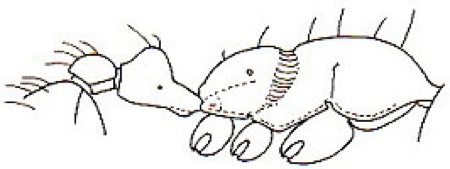 rhopalocerum
- with relatively small eyes, maximum diameter 0.18-0.20 X HW; TL
2.0-2.2 mm; dull yellow, gaster may be brownish - South Africa rhopalocerum
- with relatively small eyes, maximum diameter 0.18-0.20 X HW; TL
2.0-2.2 mm; dull yellow, gaster may be brownish - South Africa |
137 |
| . | . | 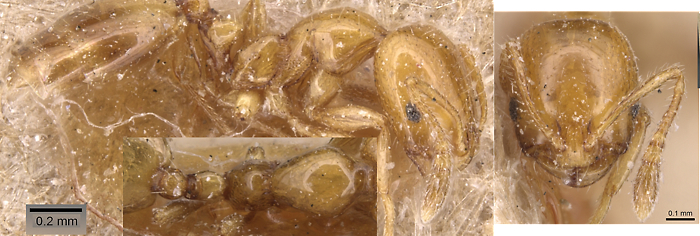 |
. |
| . | . | Eyes larger 0.20-0.25 X HW | . |
| . | . | 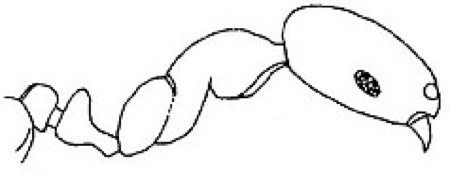 tablense
- petiole with high narrow node; TL 2.1-2.2 mm; brownish-yellow to
light brown - South Africa tablense
- petiole with high narrow node; TL 2.1-2.2 mm; brownish-yellow to
light brown - South Africa |
138 |
| . | . |  |
. |
| . | . |  termitobium
exchao - petiole node a lower dome but still relatively narrow
apically; promesonotal dorsum with 4 + pairs of erect hairs; TL 1.9-2.0
mm; uniform yellow - South Africa termitobium
exchao - petiole node a lower dome but still relatively narrow
apically; promesonotal dorsum with 4 + pairs of erect hairs; TL 1.9-2.0
mm; uniform yellow - South Africa |
140 |
| . | . | 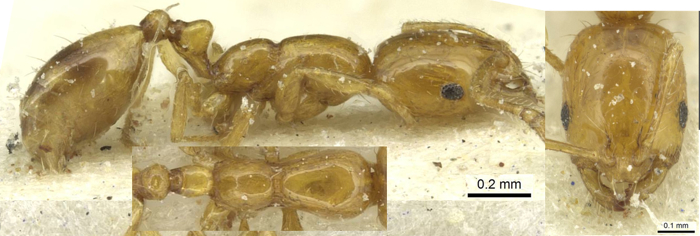 |
. |
| . | . | 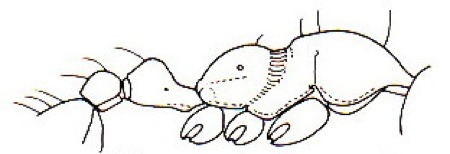 symmotu
- petiole with a low rounded node; promesonotal dorsum with 3 pairs of
erect hairs; TL 1.8-1.9 mm; yellow - Zimbabwe symmotu
- petiole with a low rounded node; promesonotal dorsum with 3 pairs of
erect hairs; TL 1.8-1.9 mm; yellow - Zimbabwe |
140 |
| . | . | 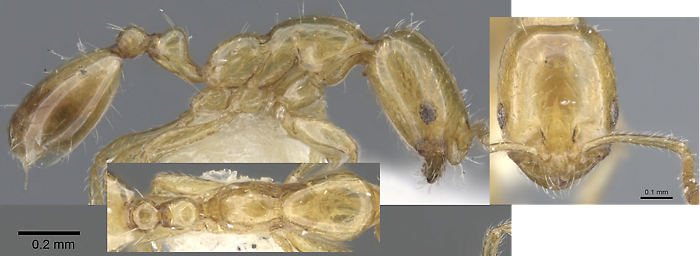 . . |
|
| strangulatum-complex | 5 | Sharp but well-separated clypeal carinae, without anterior teeth; scapes surpass occiput; petiole with long narrow pedicel (note M. strangulatum has 11-segmented antennae) | |
| . | . |  egens -
head with weakly concave occiput; promesonotum with flat dorsum and
angled margins; TL 2.0-2.5 mm; brown to blackish brown - West Africa
& Congo Basin egens -
head with weakly concave occiput; promesonotum with flat dorsum and
angled margins; TL 2.0-2.5 mm; brown to blackish brown - West Africa
& Congo Basin |
98 |
| . | . |  egens egens |
. |
| . | . | Promesonotum convex and without angled margins | . |
| . | . | 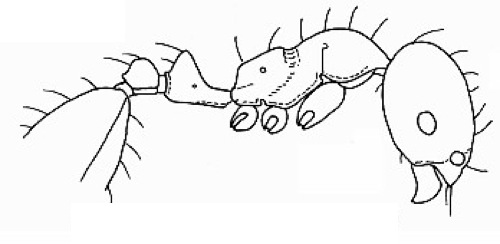 gabrielense
- West Africa
& Congo Basin
- pale yellow with a brownish gaster; TL 1.5-1.6 mm gabrielense
- West Africa
& Congo Basin
- pale yellow with a brownish gaster; TL 1.5-1.6 mm |
103 |
| . | . | 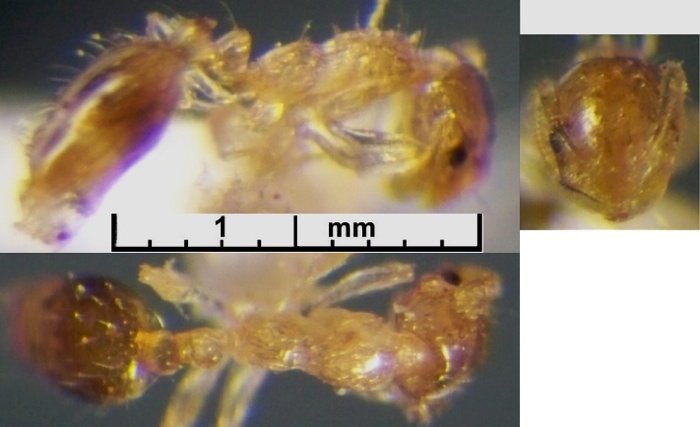 gabrielense gabrielense |
. |
| . | . | 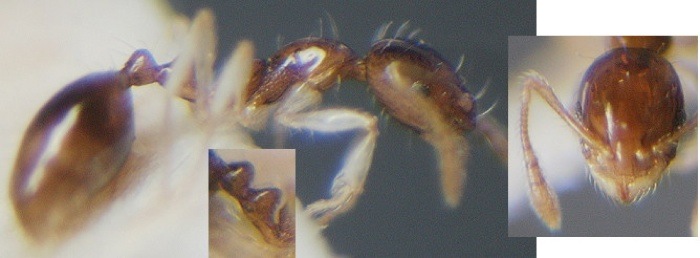 draxocum
- head with convex occipitum, in profile both dorsum and ventral head
convex; mesopleuron with distinct reticulo-puncturation; dark brown
with very pale legs; TL1.7-1.9 mm; - Cameroun to Angola draxocum
- head with convex occipitum, in profile both dorsum and ventral head
convex; mesopleuron with distinct reticulo-puncturation; dark brown
with very pale legs; TL1.7-1.9 mm; - Cameroun to AngolaNote: Bolton (1987) felt that draxocum and noxitum might well be synonymous. |
105 |
| . | . | 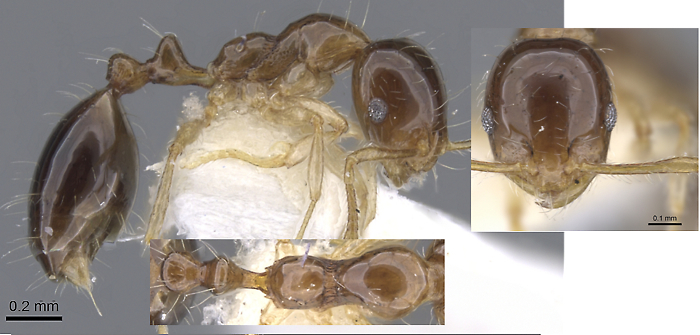 noxitum
- legs contrast with brown body but are yellowish, gaster blackish; TL
2.0-2.1 mm - Cameroun noxitum
- legs contrast with brown body but are yellowish, gaster blackish; TL
2.0-2.1 mm - Cameroun |
105 |
| malatu-complex | 5 | Petiole node high, narrow or cuneate in profile, petiole with pronounced antero-ventral process - that is according to Bolton. However, the visual evidence is of a postero-ventral bulge below the petiole node. | |
| . | . |  dolatu -
unique to complex as having 11-segmented antennae; TL 1.4-1.5 mm;
yellow, posterior of head darker and transverse dark band on first
gastral tergite - West Africa - note the image is representative of
specimens from Cameroun all of which have 12-segmented antennae dolatu -
unique to complex as having 11-segmented antennae; TL 1.4-1.5 mm;
yellow, posterior of head darker and transverse dark band on first
gastral tergite - West Africa - note the image is representative of
specimens from Cameroun all of which have 12-segmented antennae |
148 |
| . | . | 12-segmented antennae | . |
| . | . | Dorsum of propodeum sculptured; dark brown to blackish brown | . |
| . | . | 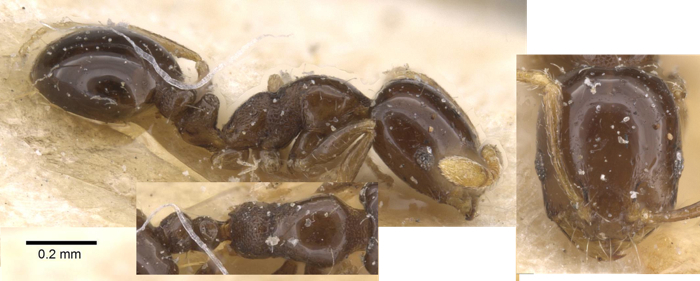 affabile
- smaller, TL 1.5 mm; with a narrower head and proportionally longer
scapes SI 88; clypeal carinae sharper - Zaïre affabile
- smaller, TL 1.5 mm; with a narrower head and proportionally longer
scapes SI 88; clypeal carinae sharper - Zaïre |
84 |
| . | . | 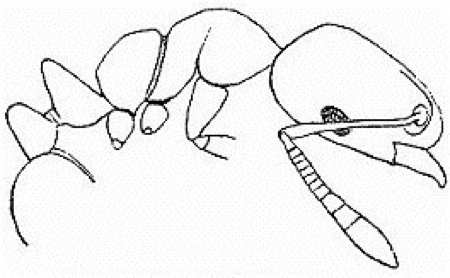 malatu
- larger, TL 1.9-2.1 mm; with a wider head and relatively shorter
scapes, SI 80-85; propodeum reticulo-punctate - Congo Basin into Uganda
forests malatu
- larger, TL 1.9-2.1 mm; with a wider head and relatively shorter
scapes, SI 80-85; propodeum reticulo-punctate - Congo Basin into Uganda
forests |
84 |
| . | . | 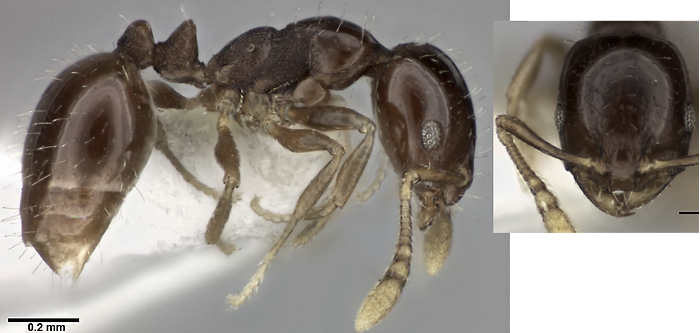 malatu malatu |
. |
| . | . | Dorsum of propodeum unsculptured; all over smooth and shiny | . |
| . | . |  disoriente
- maximum diameter of eye 0.24 X HW, SI 92; TL 1.8 mm; glossy pale
brown, gaster slightly darker - Tanzania disoriente
- maximum diameter of eye 0.24 X HW, SI 92; TL 1.8 mm; glossy pale
brown, gaster slightly darker - Tanzania |
125 |
| . | . | 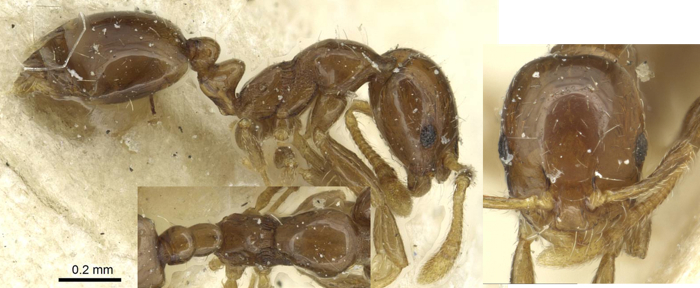 |
.5 |
| . | . |  tanysum
- maximum diameter of eye 0.17-0.18 X HW, SI 86-88; TL 1.5-1.6 mm;
brown with gaster darker almost blackish brown - Ghana tanysum
- maximum diameter of eye 0.17-0.18 X HW, SI 86-88; TL 1.5-1.6 mm;
brown with gaster darker almost blackish brown - Ghana |
125 |
| iyenasu-complex | 1 | Large size, small eyes, short scapes & very dense pilosity | |
| . | . | 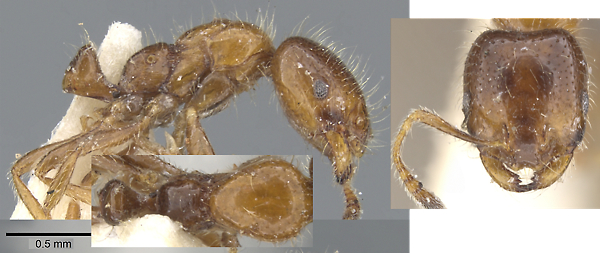 iyenasu
- TL ca 3.5 mm; yellowish-brown, occiput and apical gaster darker -
Tanzania iyenasu
- TL ca 3.5 mm; yellowish-brown, occiput and apical gaster darker -
Tanzania |
97 |
| boerorum-complex | 15 | Convenience lumping of remaining species with 12-segmented antennae | |
| sub-complex B | 6 | Antennae 12-segmented; eyes reduced with a ring of ommatidia enclosing a single longitudinal row of 2-4 ommatidia; propodeal profile may be quite domed | |
| . | . | 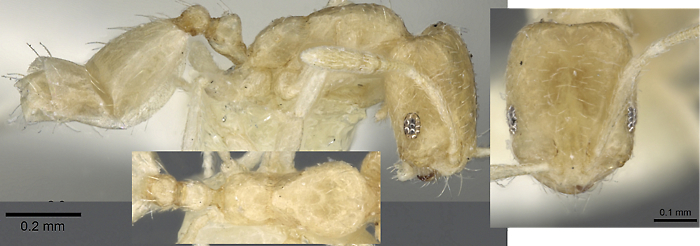 sryetum
- promesonotal dorsum with only one pair of erect hairs; propodeum
without erect hairs; TL 1.5 mm; vary pale yellow, gaster whitish yellow
- Botswana sryetum
- promesonotal dorsum with only one pair of erect hairs; propodeum
without erect hairs; TL 1.5 mm; vary pale yellow, gaster whitish yellow
- Botswana |
92 |
| . | . | Promesonotal dorsum with more than one pair of erect hairs; propodeum with at least one pair of erect hairs | . |
| . | . | Dorsum of head medium to blackish brown | . |
| . | . |  floricola
- bicoloured, head dark brown, alitrunk lighter, usually yellow;
anterior margin of clypeus with prominent median section; TL 1.7-2.0 mm
- pantropical tramp floricola
- bicoloured, head dark brown, alitrunk lighter, usually yellow;
anterior margin of clypeus with prominent median section; TL 1.7-2.0 mm
- pantropical tramp |
94 |
| . |  floricola floricola |
. | |
| . | . | 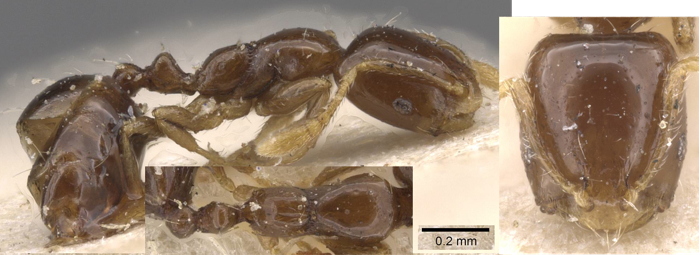 inquietum
- head and alitrunk the same shade of brown; anterior margin of clypeus
evenly convex; TL 1.7-1.8 mm - Zaïre inquietum
- head and alitrunk the same shade of brown; anterior margin of clypeus
evenly convex; TL 1.7-1.8 mm - Zaïre |
94 |
| . | . | Dorsum of head pale yellow to dingy yellow | . |
| . | . |  shilohense
- first gastral tergite evenly yellow; eye max diameter 0.23-0.24 X HW;
TL 1.5-1.6 mm - Zimbabwe shilohense
- first gastral tergite evenly yellow; eye max diameter 0.23-0.24 X HW;
TL 1.5-1.6 mm - Zimbabwe |
95 |
| . | . | First gastral tergite with basal half yellow, apex brown | . |
| . | . | 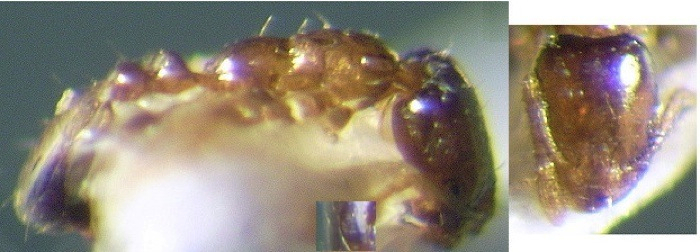 trake
- small species, TL 1.6 mm; with relatively short scapes SI 73 - Ghana trake
- small species, TL 1.6 mm; with relatively short scapes SI 73 - Ghana |
96 |
| . | . |  rotundatum
- larger species, TL 1.7-2.0 mm; with relatively longer scapes SI 79-83
- Kenya, South Africa rotundatum
- larger species, TL 1.7-2.0 mm; with relatively longer scapes SI 79-83
- Kenya, South Africa |
96 |
| . |
. |
 rotundatum rotundatum |
. |
| sub-complex C | 9 | Antennae 12-segmented; eye with two or more median longitudinal rows; propodeal profile essentially domed; petiole quite short and in most with a narrow, blade-like subpetiolar process | |
| . | . |  kelapre
- propodeal spiracle with a large conspicuous circular opening; TL 1.9
mm; glossy light brown - South Africa kelapre
- propodeal spiracle with a large conspicuous circular opening; TL 1.9
mm; glossy light brown - South Africa |
115 |
| . | . | Propodeal spiracle with a minute circular opening | . |
| . | . | 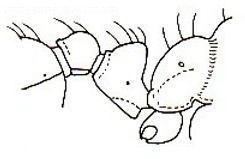 lubricum
- anterior ventral process of petiole a large keel-like translucent
lamina; TL 2.3-2.5 mm; glossy dark brown- South Africa lubricum
- anterior ventral process of petiole a large keel-like translucent
lamina; TL 2.3-2.5 mm; glossy dark brown- South Africa |
133 |
| . | . | Subpetiolar process much less prominent | . |
| . | . | Relatively large species, TL at least 1.8 mm | . |
| . | . | 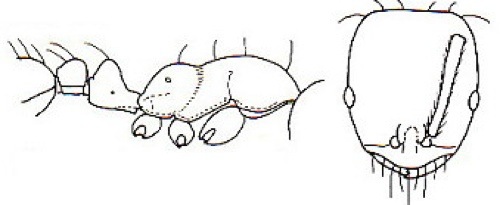 boerorum
- clypeus with vestigial or no carinae, anterior margin evenly and
broadly convex, TL 1.9-2.0 mm; eyes 0.19-0.21 X HW; glossy dark brown -
South Africa boerorum
- clypeus with vestigial or no carinae, anterior margin evenly and
broadly convex, TL 1.9-2.0 mm; eyes 0.19-0.21 X HW; glossy dark brown -
South Africa |
135 |
| . | . | 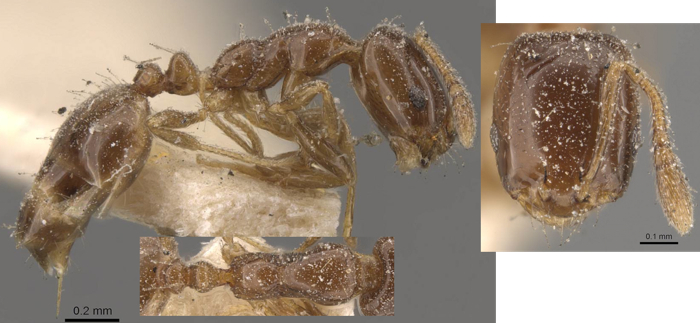 |
. |
| . | . | 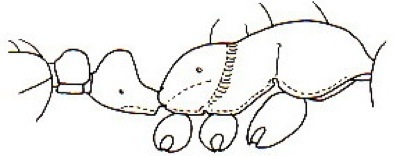 paternum
- clypeus with well developed carinae and projecting centre to anterior
margin; TL 2.3 mm; eyes 0.18 X HW; glossy medium to dark brown - South
Africa paternum
- clypeus with well developed carinae and projecting centre to anterior
margin; TL 2.3 mm; eyes 0.18 X HW; glossy medium to dark brown - South
Africa |
137 |
| . | . |  |
. |
| . | . |  nuptialis
- clypeus with well developed carinae and projecting centre to anterior
margin; TL 1.8 mm; eyes 0.22 X HW; glossy light brown to yellowish
brown - Zimbabwe nuptialis
- clypeus with well developed carinae and projecting centre to anterior
margin; TL 1.8 mm; eyes 0.22 X HW; glossy light brown to yellowish
brown - Zimbabwe |
139 |
| . | . | Small species TL < 1.7 mm | . |
| . | . |  braunsi
- promesonotum with a single pair of erect hairs at humeral angles;
petiole node very low and rounded; TL 1.6 mm; uniformly yellow - South
Africa braunsi
- promesonotum with a single pair of erect hairs at humeral angles;
petiole node very low and rounded; TL 1.6 mm; uniformly yellow - South
Africa |
141 |
| . | . | Promesonotum with 3-5 pairs of erect hairs; petiole node subconical | . |
| . | . | 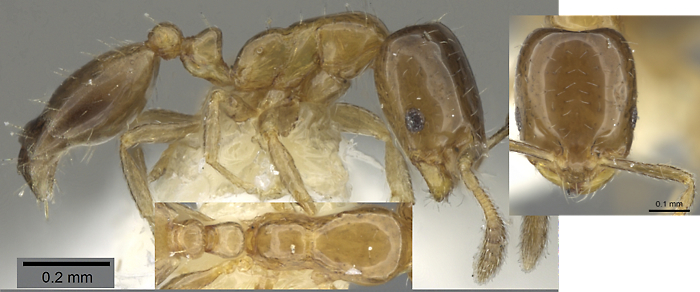 mavide
-
minute with small eyes; TL 1.4-1.5 mm, eyes 0.19 x HW; head and gaster
brown, alitrunk light brownish-yellow - South Africa mavide
-
minute with small eyes; TL 1.4-1.5 mm, eyes 0.19 x HW; head and gaster
brown, alitrunk light brownish-yellow - South Africa |
143 |
| . | . | 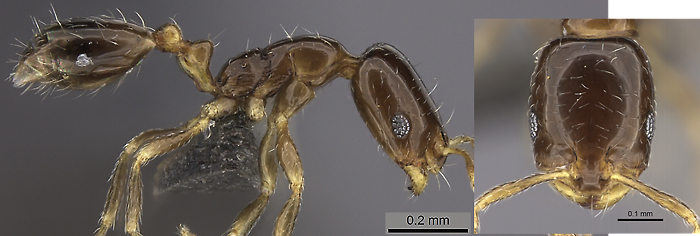 torvicte
- uniformly dark brown, TL 1.5-1.6 mm; SI 76-80, eye 0.20-0.21 X HW -
South Africa torvicte
- uniformly dark brown, TL 1.5-1.6 mm; SI 76-80, eye 0.20-0.21 X HW -
South Africa |
144 |
| . | . |  musicum
- uniformly yellow, TL 1.6-1.7 mm; SI 81-84, eye 0.22-0.24 X HW - South
Africa musicum
- uniformly yellow, TL 1.6-1.7 mm; SI 81-84, eye 0.22-0.24 X HW - South
Africa |
144 |
| MYRMICINAE Introduction |
© 2007, 2008, 2009, 2010, 2011, 2013, 2014, 2015 -
Brian
Taylor
CBiol FSB FRES 11, Grazingfield, Wilford, Nottingham, NG11 7FN, U.K. |
href="monomorium_groups.htm"